WHO in India

October 2025 | Gajapati, Odisha
WHO National Public Support Network (WHO-NPSN) personnel accompanying government health workers delivering vaccines to rural settlements in Gajapati district in Odisha during the Sub National Immunization Day on 14 October 2025. WHO-NPSN provided planning, capacity building and monitoring support to the district health department to help ensure no child was left behind, particularly in high-risk areas. (© WHO India / Sagar Mohanty)
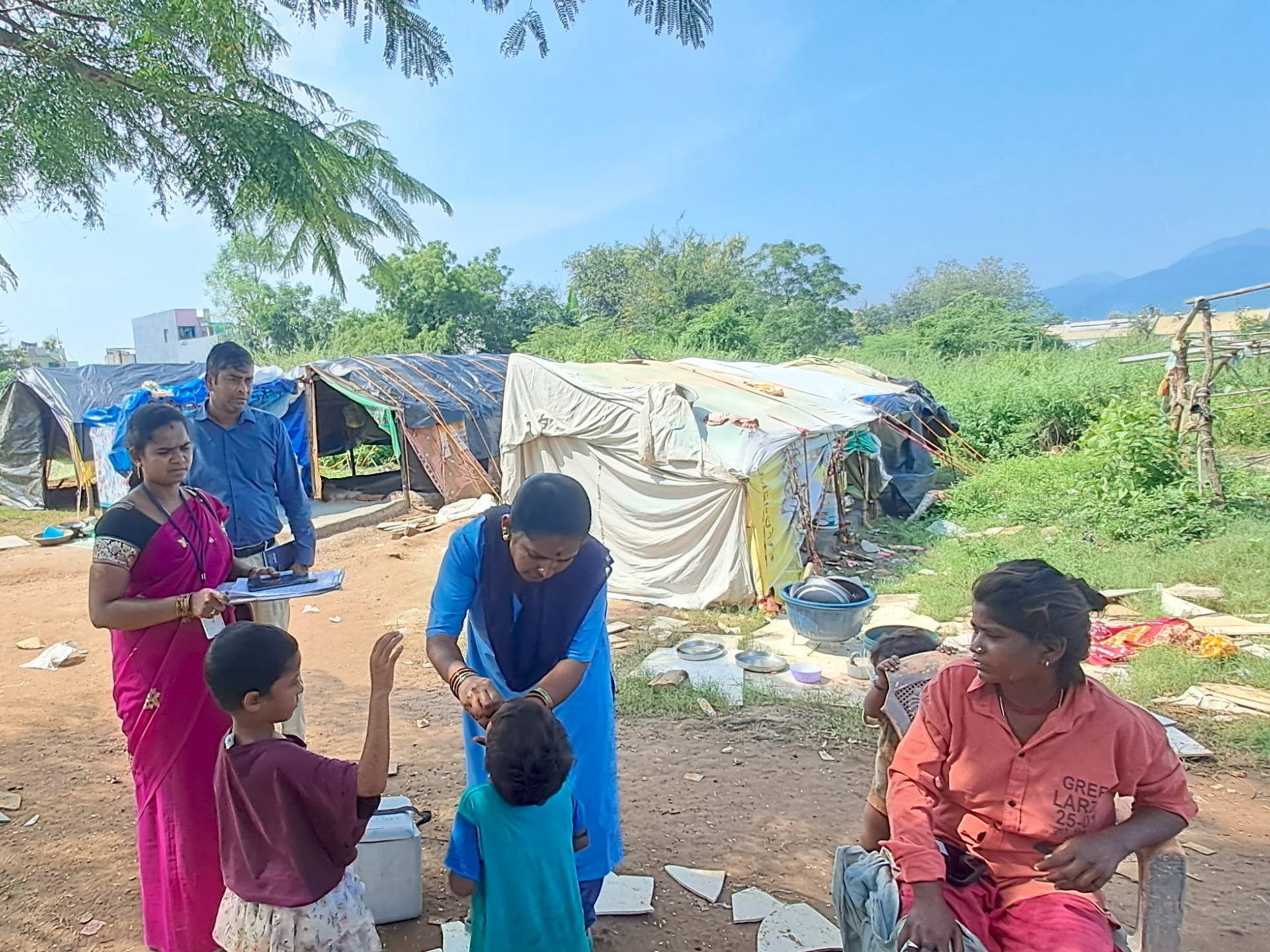
October 2025 | Gajapati, Odisha
To ensure that no child missed out on lifesaving vaccines, a WHO National Public Support Network field team supported the district health department in monitoring immunization activities at the Ram Nagar nomadic site, located in the peri-urban area of Paralakhemundi in Gajapati district, during the Sub National Immunization Day on 14 October 2025. (© WHO India / Sagar Mohanty)

October 2025 | Jodhpur, Rajasthan
WHO India worked with the Government of Rajasthan and programme officers in Jodhpur for training ASHAs on NCD documentation, follow-ups for hypertension and diabetes, and using the Pregnancy, Child Tracking and Health Services Management System mobile app for incentive claims. WHO also supported the development of video tutorials in the local language to help ASHAs use the app. (Photo: © WHO India / Bimlesh Kumar Sinha)
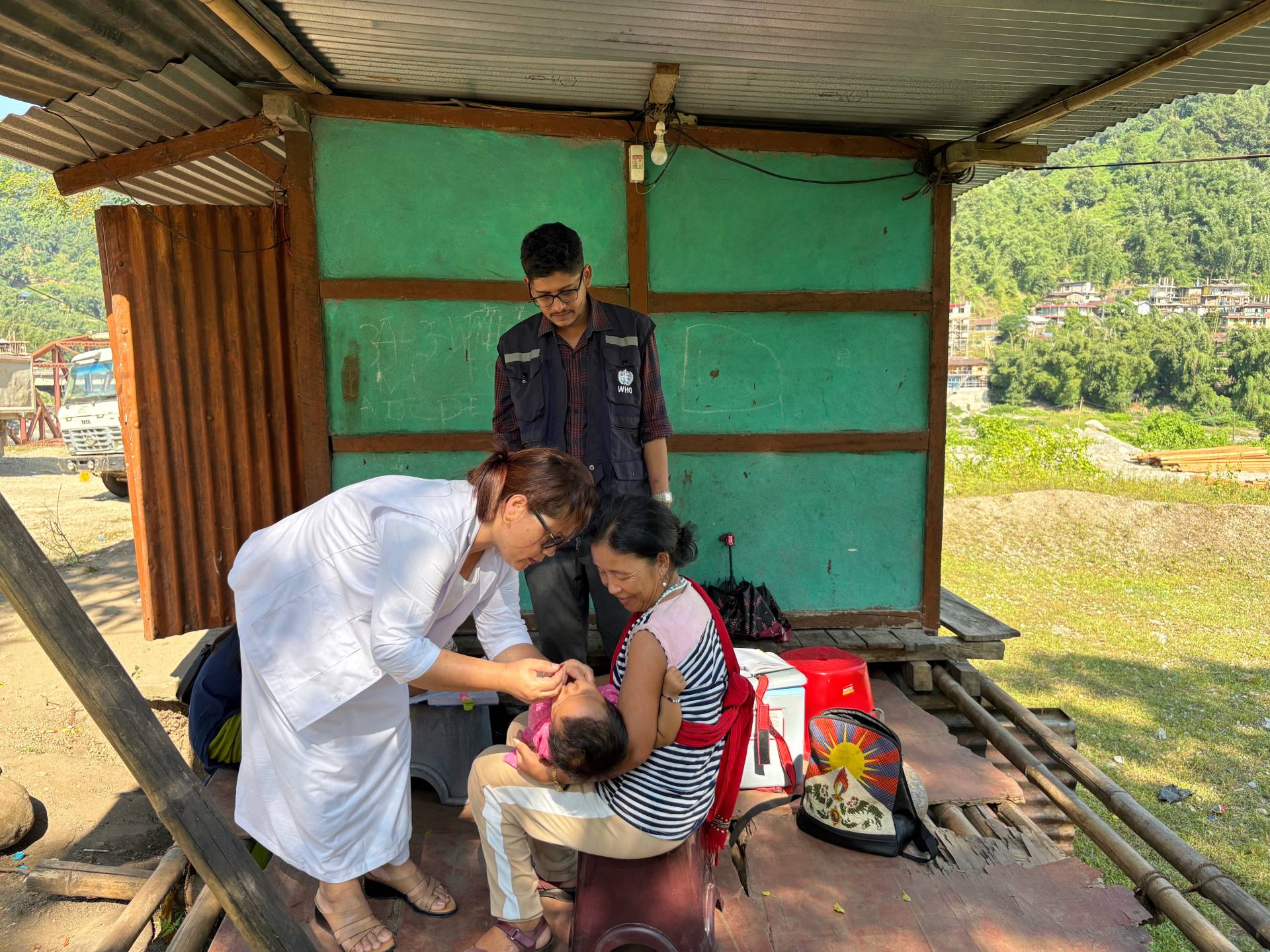
October 2025 | East Kameng, Arunachal Pradesh
A mother getting her child vaccinated at an immunization outreach session in Pachan Morang Colony, East Kameng district, Arunachal Pradesh. Supported by WHO India, a team from District Hospital Seppa and ASHAs are strengthening routine immunization across 52 settlements, aiming for 95% coverage and preventing outbreaks like Measles-Rubella through strong community participation and awareness. (© WHO India / Ram Prasad Dorjee)
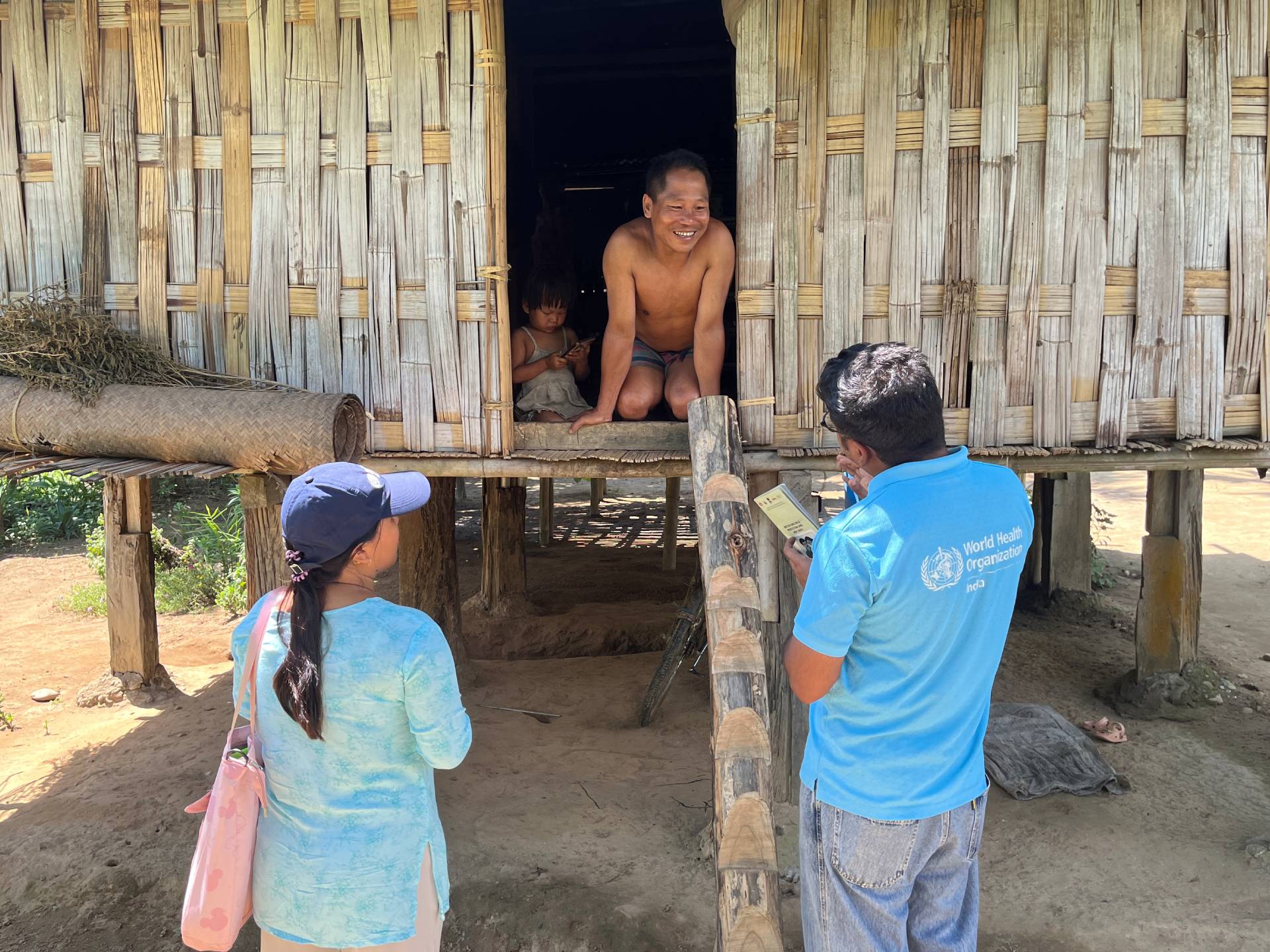
October 2025 | East Kameng, Arunachal Pradesh
On 19 September 2025, a WHO field team visited Aranyapur village under Community Health Centre Diyun in Changlang district and identified 10 children who had missed routine immunizations, including three who had never been vaccinated. The team counselled families and coordinated with government health teams to immunize all children during an outreach session—demonstrating the power of collaboration to reach underserved communities. (© WHO India / Puron Urang)
/countries/india/eye-exam-with-slit-lamp-microscope.jpg?sfvrsn=d6c2a671_2)
October 2025 | Bengaluru, Karnataka
Ms Selvi B., 65, undergoes a follow-up eye check-up at Bruhat Bengaluru Mahanagara Palike Multispeciality Hospital in MC Layout, Bengaluru, six weeks after a successful cataract surgery under the Government of Karnataka's Asha Kirana programme. Since its launch in 2022, ASHAs are visiting homes to screen vision in the community, and comprehensive eye checkups, spectacles and cataract surgeries are being provided by the state to those who need them. (Photo: © WHO India / Anshu Shekhar Roy)
/countries/india/october-2025-chikkaballapur-karnataka.jpg?sfvrsn=8c177dc4_10)
October 2025 | Chikkaballapur, Karnataka
Mr S. D. Ramchandrappa, 74, from Sabbenahalli village in Chikkaballapur district, beams with joy after receiving a new pair of spectacles free of cost under the Government of Karnataka’s Asha Kirana programme. Over 1.2 million free spectacles have been provided to those who need them under the programme, which offers integrated people-centered eye care services to all across the state. (Photo: © WHO India / Anshu Shekhar Roy)
.jpg?sfvrsn=b42f104_3)
September 2025 | West Kameng, Arunachal Pradesh
In Khellong village under Nafra Community Health Centre, a WHO team worked with health workers, community mobilisers and local influencers to reach vaccine-hesitant families in their homes and encourage them to get their children vaccinated. As a result, eight children received life-saving vaccines, with two of them catching up on missed measles-rubella doses. (Photo: © WHO India / Nima Tsering Bapu)
/countries/india/district-health-officials-organized-a-routine-immunization-outreach-session-led-by-mrs-yani-lida.jpg?sfvrsn=56879d0f_3)
September 2025 | Upper Subansiri, Arunachal Pradesh
District health officials organized a routine immunization outreach session led by Mrs Yani Lida, auxiliary nurse midwife from Health and Wellness Centre Haji, in the hard-to-reach villages of Degu and Gete Degu in Upper Subansiri district with support from ASHAs and a WHO field team. Four children were immunized, including two with MR doses. (Photo: © WHO India / Ram Prasad Dorjee)
/countries/india/makeshift-colour-coded-waste-collection-bags-being-used-at-a-temporary-routine-immunization-site-in-health-and-wellness-centre.jpg?sfvrsn=83867c34_3)
September 2025 | Upper Subansiri, Arunachal Pradesh
Makeshift colour-coded waste-collection bags being used at a temporary routine immunization site in Health and Wellness Centre Haji to ensure proper segregation and disposal of biomedical waste, such as used syringes and cotton, in the Upper Subansiri district. (Photo: © WHO India / Ram Prasad Dorjee)
/countries/india/who-field-monitoring-teams-identified-mopa-tea-village-under-community-health-centre-kanubari.jpg?sfvrsn=1dc59b4_6)
September 2025 | Longding, Arunachal Pradesh
WHO field monitoring teams identified Mopa Tea village under Community Health Centre Kanubari near the Assam-Arunachal as a high-risk area due to its high migration population. The WHO team identified two newly-settled families with children who had missed immunization doses. A pregnant woman in her third trimester who had not undergone any ante-natal check-up was also identified and counselled on the importance of ANC, regular check-ups, and institutional delivery. (Photo: © WHO India / Lemkai Arangham)
.jpg?sfvrsn=b5ba771a_3)
September 2025 | West Kameng, Arunachal Pradesh
September 2025 | West Kameng, Arunachal Pradesh WHO teams monitored immunization outreach sessions in Ditchik village under Nafra Community Health Centre, on 8 September. Home visits and counselling of parents led to eight children being immunized in the village, categorized as a ‘high-risk area’ because of vaccine-hesitancy among some families. (Photo: © WHO India / Nima Tsering Bapu)
/countries/india/a-community-gathers-outside-their-traditional-thatched-roof-hut-in-a-rural-area--engaging-in-daily-activities.jpg?sfvrsn=7faef0d7_3)
September 2025 | Longding, Arunachal Pradesh
WHO-supported monitoring teams identified a “zero” dose child who had never been vaccinated, and two “dropout” children who had missed their first and second dose of measles-rubella vaccination, respectively, in Mopa Tea village under Community Health Centre (CHC) Kanubari near the Assam-Arunachal border. Information about the children was shared with CHC Kanubari for necessary follow-up. (Photo: © WHO India / Lemkai Arangham)
/countries/india/who-field-team-supported-a--catch-up--training-of-frontline-health-workers-at-bajengdoba-primary-health-centre-in-the-north-garo-hills-district--meghalaya.jpg?sfvrsn=b354e18f_3)
August 2025 | North Garo Hills, Meghalaya
WHO field team supported a “catch-up’ training of frontline health workers at Bajengdoba Primary Health Centre in the North Garo Hills district, Meghalaya. Trainers discussed vaccine-preventable diseases, the importance of vaccination, the format of headcount surveys, and the need to ensure every child is fully immunized. (Photo: © WHO India / Abel Marak)
/countries/india/in-a-training-session-for-frontline-health-workers-at-bajengdoba-primary-health-centre.jpg?sfvrsn=3b513d96_3)
August 2025 | North Garo Hills, Meghalaya
In a training session for frontline health workers at Bajengdoba Primary Health Centre in the North Garo Hills district, Meghalaya, WHO field team discussed strategies to further reduce “zero dose” children, who have not received a single childhood vaccine. (Photo: © WHO India / Noor Jamal Hoque)
/countries/india/who-teams-joined-auxiliary-nurse-midwives-and-a-multipurpose-worker-from-sood-subcentre-to-visit--refusal--households-in-sood-village.jpg?sfvrsn=ba92832a_3)
August 2025| Itanagar, Arunachal Pradesh
WHO teams joined auxiliary nurse midwives and a multipurpose worker from Sood Subcentre to visit “refusal” households in Sood village, Naharlagun, to persuade families to fully immunize their children during a health risk assessment in Itanagar Capital Region, Arunachal Pradesh. WHO provides technical and monitoring support to the Government of India for strengthening immunization services. (Photo: © WHO India / Binku Moron)
/countries/india/a-who-team-assisting-government-monitors-discussing-the-concerns-and-needs-of-mothers-of-babies-and-young-children.jpg?sfvrsn=745a4163_4)
August 2025 | North Garo Hills, Meghalaya
Government monitors discussing the concerns and needs of mothers of babies and young children as part of immunization surveys being conducted under the Behavioural and Social Drivers initiative supported by WHO field team in the North Garo Hills district in Meghalaya (Photo: © WHO India / Abel Marak)
/countries/india/a-routine-immunization-orientation-and-microplan-review-workshop-was-held-at-gabil-primary-health-centre.jpg?sfvrsn=56d7bcfa_4)
August 2025 |North Garo Hills, Meghalaya
A routine immunization orientation and microplan review workshop was held at Gabil Primary Health Centre, Resubelpara block, North Garo Hills, to train the medical officer, supervisor, and newly-posted auxiliary nurse midwives with support from WHO field teams. The centre serves 6105 people across 21 villages, 16 of which are high-risk due to poor connectivity. The training aims to strengthen capacity and ensure every child in these hard-to-reach areas receives timely immunization. (Photo: © WHO India / Binku Moron)
/countries/india/building-vaccine-confidence-one-conversation-at-a-time-in-meghalaya.jpg?sfvrsn=6cb0e9dc_4)
August 2025 | North Garo Hills, Meghalaya
WHO teams provided mentoring and guidance to government surveyors in the implementation of the Behavioural and Social Drivers initiative designed to deep-dive into the perceptions and concerns of the community around immunization to identify the hidden stories and voices that mattered. (Photo: © WHO India / Abel Marak)
/countries/india/a-who-rapid-response-team-helped-an-asha.jpg?sfvrsn=19a7f98b_3)
July 2025 | West Jaintia Hills, Meghalaya
A WHO rapid response team helped an ASHA (community health volunteer) and auxiliary nurse midwife from Nongkhroh sub-centre validate vaccination coverage in remote Maskut village, Thadlaskein block. Despite high overall coverage, they found four ‘zero-dose’ unvaccinated children from two families missed in the initial survey. After counselling, the families agreed to get the children vaccinated. (Photo: © WHO India / Arki Sari)
/countries/india/who-rapid-response-personnel-identified-three-drop-out-children.jpg?sfvrsn=a8d880ac_3)
July 2025 | Changlang, Arunachal Pradesh
During house-to-house monitoring in Lalung Tea Garden in Borkhet village, Bordumsa block, a team comprising district health staff and WHO rapid response personnel identified three “drop-out” children who hadn’t completed their scheduled vaccinations and one “zero-dose” unvaccinated child. A special vaccination session was held the next day to ensure they received their due vaccines. (Photo: © WHO India)
/countries/india/who-has-assisted-the-district-health-department-in-the-setting-up-of-bimonthly-vaccination-sessions.jpg?sfvrsn=9fc52df4_4)
July 2025 | West Kameng, Arunachal Pradesh
WHO has assisted the district health department in the setting up of bimonthly vaccination sessions in Rangthangjorpam village, home to 450 people from a farming community. The nearest Health and Wellness Centre in Angkaling is 5 km away. With roads in this hilly and forested area becoming unmotorable during the rainy season, access to essential health services is often difficult. (Photo: © WHO India)
/countries/india/a-trained-health-inspector-uses-the-2022-who-verbal-autopsy-tool-for-electronic-data-collection.jpg?sfvrsn=5caecf33_4)
June 2025 | Karur, Tamil Nadu
A trained health inspector uses the 2022 WHO verbal autopsy tool for electronic data collection on the Open Data Kit (ODK) platform on his tablet in Vangal, Karur, Tamil Nadu. WHO teams train and supervise health inspectors to ensure accurate and timely data submission in the physician-certified verbal autopsy (PCVA) portal. (© UN in India and WHO India/Ruhani Kaur)
/countries/india/a-village-administrative-officer-(vao)-registering-a-death-and-the-cause-of-death-on-the-e-mor-software.jpg?sfvrsn=1010c018_3)
June 2025 | Karur, Tamil Nadu
A village administrative officer (VAO) registering a death and the cause of death on the e-Mor software in the Panchayat Office in Manavadi village, Thanthoni block, Karur, Tamil Nadu. WHO provides supportive supervision to VAO officers on cause-of-death death reporting, including documentation for the medical certification of cause of death. (© UN in India and WHO India/Ruhani Kaur)
/countries/india/a-verbal-autopsy-interview-in-progress-in-karur--tamil-nadu.jpg?sfvrsn=70941f3c_3)
June 2025 | Karur, Tamil Nadu
A verbal autopsy interview in progress in Karur, Tamil Nadu, where a trained interviewer visits the family of the deceased to document the circumstances leading to the death. The interview includes an 'open narrative’, where the caregivers describe the medical history and circumstances of death in their own words. WHO supervises verbal autopsies to provide feedback to improve data quality. (© UN in India and WHO India/Ruhani Kaur)
/countries/india/a-medical-officer-reviews-the-verbal-autopsy-data-and-case-histories-1.jpg?sfvrsn=cbe488_3)
June 2025 | Karur, Tamil Nadu
A medical officer reviews the verbal autopsy data and case histories submitted by interviewers on the physician-certified verbal autopsy (PCVA) portal to assign probable causes of death at Karur Urban Primary Health Centre, Karur, Tamil Nadu. WHO trains medical officers on using the International Classification of Diseases (ICD-11) coding tool and provides supportive supervision to resolve case-related queries. (© UN in India and WHO India/Ruhani Kaur)
/countries/india/a-who-national-public-support-network-team-conducted-house-to-house-monitoring-of-immunization-activities-for-preventing-potential-outbreaks.jpg?sfvrsn=d7fb61db_3)
April 2025| Sahibganj, Jharkhand
A WHO-National Public Health Support Network team conducted house-to-house monitoring of immunization activities for preventing potential outbreaks of vaccine-preventable diseases and bolstering routine immunization coverage in the hard-to-reach Rampur village in Sahibganj district. The team visited 140 households and monitored the vaccination status of 94 children on 23 April. (Photo: © WHO India / Dharun Prasad)
/countries/india/a-who-national-public-support-network-team-loading-their-mobikes-on-a-rowboat.jpg?sfvrsn=bffaf59a_4)
April 2025 | Sahibganj, Jharkhand
A WHO-National Public Health Support Network team loading their mobikes on a rowboat to travel 1.5 km down the Mayurakshi river to visit the hard-to-reach Rampur Health Sub-Center in Sahibganj district. The team conducted house-to-house monitoring of immunization activities to bolster routine immunization coverage in the district on 23 April. (Photo: © WHO India / Dharun Prasad)
/countries/india/new-mother-mrs-pooja-holds-her-one-day-old-son-at-the-maternity-home-yamuna-vihar--delhi.jpg?sfvrsn=76965345_3)
April 2025 | North East Delhi
New mother Mrs Pooja holds her one-day-old son at the Maternity Home Yamuna Vihar, Delhi. The Maternity Home provides comprehensive health services and care, including nutrition and breastfeeding guidance, to ensure the baby has a healthy start in life. (Photo: © WHO India / Rajiv Solanki)
/countries/india/as-an-asha-(accredited-social-health-activist)--ms-kavita-ensures-mrs-vidhi--who-is-pregnant-with-her-first-child--receives-her-due-health-check-ups-and-vaccinations-for-a-safe-pregnancy.jpg?sfvrsn=d69d63b1_3)
April 2025 | North East Delhi
As an ASHA (accredited social health activist), Ms Kavita ensures Mrs Vidhi, who is pregnant with her first child, receives her due health check-ups and vaccinations for a safe pregnancy. She also provides nutrition guidance to the family to ensure the mother and baby have a healthy beginning and a hopeful future. (Photo: © WHO India / Rajiv Solanki)
/countries/india/mothers-waiting-to-get-their-children-immunized-at-maternity-home-yamuna-vihar-in-the-north-east-district-of-delhi.jpg?sfvrsn=4705f16a_3)
April 2025 | North East Delhi
Mrs Preeti (left) with her daughter Aradhya, and Mrs Khusboo (right) with her son Siddhik and daughter Kavya wait to get their children immunized at Maternity Home Yamuna Vihar in the North East District of Delhi. WHO provides technical and monitoring support to the Government of India for strengthening immunization services. (Photo: © WHO India / Rajiv Solanki)
/countries/india/eastern-west-khasi-hills--meghalaya.jpg?sfvrsn=5506baef_4)
January 2025 | Eastern West Khasi Hills, Meghalaya
WHO National Public Health Support Network field team in Meghalaya supported the district administration and the block health workforce in conducting a measles outbreak investigation in March 2024 in Mairang block in Eastern West Khasi Hills. (Photo: © WHO India / Pradeep Modak)
/countries/india/west-garo-hills--meghalaya.jpg?sfvrsn=2b41e446_3)
January 2025 | Ri Bhoi, Meghalaya
A WHO field team participating in community outreach activities to address vaccine-hesitancy and strengthen routine immunization system in a village under Patharkakmah Community Health Centre in Ri Bhoi district. (Photo: © WHO India / Pradeep Modak)
/countries/india/ri-session-site-monitoring-at-est-kameng.jpeg?sfvrsn=f691d2b9_4)
January 2025 | East Kameng, Arunachal Pradesh
A WHO National Public Health Support Network field team assisting the district administration in supportive supervision of a routine immunization session site set up to reach unreached children and pregnant women in the hard-to-reach Jamoh village in East-Kameng district. (Photo: © WHO India / Sono Lingfa)
/countries/india/siang--arunachal-pradeshccdc4aa0-dccb-4a87-90d2-92cbdbfe5554.jpg?sfvrsn=d2431f9e_3)
January 2025 | Siang, Arunachal Pradesh
An auxiliary nurse midwife carrying vaccines on a suspended bridge over the Siang river to an outreach session site in the hard-to-reach Mopit village in Boleng block, Siang district in 2024. (Photo: © WHO India / Memtatak)
2024
/countries/india/ms-sunduki-tarang--ms-jamina-rongchong-and-mr-mohan-rongpeh-donning-spectacles-they-received-free-under-a-social-community-outreach-programme.jpg?sfvrsn=5e524040_3)
November 2024 | Kamrup Metropolitan, Assam
Ms Sunduki Tarang, Ms Jamina Rongchong and Mr Mohan Rongpeh donning spectacles they received free under a social community outreach programme. WHO is supporting the Government of Assam roll out SPECS 2030 (Strengthening Provision of Eye Care Services) in phases to provide access to quality, affordable and people-centred refractive error services, including provision of free spectacles. (Photo: @ WHO India / Sanchita Sharma)
/countries/india/village-head-ms-joram-mach-and-gram-panchayat-(village-council)-member-mr-joram-chilly-with-ms-gida-sangeeta--senior-nurse-officer-at-primary-health-centre-yachuli.jpg?sfvrsn=f29adb85_3)
November 2024 | Lower Subansiri, Arunachal Pradesh
Village head Ms Joram Mach and gram panchayat (village council) member Mr Joram Chilly with Ms Gida Sangeeta, senior nurse officer at Primary Health Centre Yachuli. Yachuli was declared a “TB Free Panchayat” in 2023, and is now working towards meeting the criteria for achieving National Quality Assurance Standards (NQAS) certification. (Photo: @ WHO India / Sanchita Sharma)
/countries/india/tuberculosis-screening-is-a-part-of-routine-antenatal-care-at-bhakatiduar-ayushman-arogya-mandir-(aam)--community-health-officer-mr-deepjyoti-baruah-told-who-representative-to-india-dr-roderico-h.-ofrin--during-h.jpg?sfvrsn=9f145c74_3)
November 2024 | Majuli, Assam
Tuberculosis screening is a part of routine antenatal care at Bhakatiduar Ayushman Arogya Mandir (AAM), Community Health Officer Mr Deepjyoti Baruah told WHO Representative to India Dr Roderico H. Ofrin, during his field visit to Assam. WHO teams are supporting Bhakatiduar AAM in strengthening health systems for meeting the national quality assurance standards. (Photo: @ WHO India / Sanchita Sharma)
/countries/india/who-field-teams-assisted-bihar-state-health-department-in-delivering-bivalent-oral-polio-(bopv)-vaccines-to-children-of-migrant-labourers-working-at-brink-kilns-during-national-immunization-day-on-24-november.jpg?sfvrsn=c8366d2c_4)
November 2024 | Vaishali, Bihar
WHO field teams assisted Bihar state health department in delivering bivalent oral polio (bOPV) vaccines to children of migrant labourers working at brink kilns during National Immunization Day on 24 November. Oral polio vaccines are given to all children under 5 years during one National Immunization Day and two SNIDs organized every year to ensure India remains polio-free. (Photo: © WHO India / Binod Kumar)
/countries/india/who-representative-to-india-dr-roderico-h.-ofrin-with-mr-rokom-gamno--a-traffic-warden-from-itanagar-who-has-been-diagnosed-with-extrapulmonary-tuberculosis-(tb).jpg?sfvrsn=632580e1_3)
November 2024 | Itanagar, Arunachal Pradesh
WHO Representative to India Dr Roderico H. Ofrin with Mr Rokom Gamno, a traffic warden from Itanagar who has been diagnosed with extrapulmonary tuberculosis (TB). Mr Gamno completed two months of his six-months TB treatment in November, and is happy to be on the road to recovery. (Photo: @ WHO India / Sanchita Sharma)
/countries/india/ms-jamina-rongchong-getting-her-vision-tested-under-the-supervision-of-dr-harsha-bhattacharjee--president--sri-sankaradeva-nethralaya--guwahati--and-aggregated-social-eye-care-activists-(aseca)-ms-kanchan-roy.jpg?sfvrsn=242ab00c_3)
November 2024 | Kamrup Metropolitan, Assam
Ms Jamina Rongchong getting her vision tested under the supervision of Dr Harsha Bhattacharjee, president, Sri Sankaradeva Nethralaya, Guwahati, and Aggregated Social Eye Care Activists (ASECA) Ms Kanchan Roy. WHO is supporting the Government of Assam roll out SPECS 2030 (Strengthening Provision of Eye Care Services) in phases to provide access to quality, affordable and people-centred refractive error services, including provision of free spectacles. (Photo: @ WHO India / Sanchita Sharma)
/countries/india/who-field-teams-assisted-the-bihar-state-health-department-in-delivering-bivalent-oral-polio-(bopv)-vaccines-in-difficult-to-reach-areas-during-national-immunization-day-on-24-november.jpg?sfvrsn=7ba755ee_4)
November 2024 | Vaishali, Bihar
WHO field teams assisted the Bihar state health department in delivering bivalent oral polio (bOPV) vaccines in difficult-to-reach areas during National Immunization Day on 24 November. WHO teams continue to provide immunization monitoring and surveillance support, with a focus on high-risk areas, to ensure India remains polio-free. (Photo: © WHO India / Binod Kumar)
/countries/india/a-who-personnel-mentoring-frontline-workers-before-a-routine-immunization-session.jpg?sfvrsn=43c6a8d6_3)
October 2024 | Sitamarhi, Bihar
A WHO personnel mentoring frontline workers before a routine immunization session in Sitamarhi district, Bihar. WHO National Public Health Support Network provides technical and monitoring support to Government of India for strengthening immunization services. (Photo: © WHO India / Jitendra Kumar Singh)
/countries/india/a-who-surveillance-medical-officer-briefing-frontline-workers-for-a-routine-immunization-session.jpg?sfvrsn=6a925aa8_3)
October 2024 | Sitamarhi, Bihar
A WHO surveillance medical officer briefing frontline workers for a routine immunization session in Sitamarhi district, Bihar. WHO National Public Health Support Network provides technical and monitoring support to Government of India for strengthening immunization services. (Photo: © WHO India / Jitendra Kumar Singh)
/countries/india/who-india-team-is-supporting-the-government-in-enhancing-the-delivery-of-primary-health-services.jpg?sfvrsn=31c98da5_3)
October 2024 | Rayagada, Odisha
WHO India team is supporting the government in enhancing the delivery of primary health services in Muniguda block in Rayagada district, Odisha. WHO provides technical support, monitoring, and mentoring to enhance access to public health care services in hard-to-reach areas under India’s Aspirational Blocks Programme. (Photo: © WHO India / Santosh Kumar Sahoo)
/countries/india/a-who-team-providing-technical-and-monitoring-support-to-frontline-workers-to-enhance-access-to-public-health-services.jpg?sfvrsn=be435ed4_3)
October 2024 | Rayagada, Odisha
A WHO team providing technical and monitoring support to frontline workers to enhance access to public health services in the Rayagada district, home to the Dongria Kondh tribe in Odisha under the Aspirational Blocks Programme. (Photo: © WHO India / Vishesh Kumar)
/countries/india/india-s-national-cadet-corps-participating-in-a-training-on-supplementary-immunization-activities.jpg?sfvrsn=4940d690_3)
October 2024 |Begusarai Bihar
India’s National Cadet Corps participating in a training on supplementary immunization activities (SIAs) in Begusarai, Bihar. SIA training provided cadets with the necessary skills to support immunization-related activities in the community. (Photo: © WHO India / Sunil Kumar)
/countries/india/who-has-validated-india-for-the-elimination-of-trachoma-as-a-public-health-problem-in-2024.jpg?sfvrsn=b5e7fbb1_4)
October 2024 | New Delhi
WHO has validated India for the elimination of trachoma as a public health problem in 2024. Ministry of Health and Family Welfare-led initiatives supported by key stakeholders, including Dr R P Centre-WHO Collaborating Centre at AIIMS New Delhi, led to this success, along with promotion of sanitation and hygiene under Swachh Bharat Mission and provision of safe water under Jal Jeevan Mission. (Photo: © WHO India / Vipul Sharma)
/countries/india/who-national-public-health-support-network-field-teams-assisted--flood-medical-teams--formed-by-the-district-administration-and-local-health-departments-in-providing-essential-medicines.jpg?sfvrsn=45f0b0bc_3)
October 2024 | West Champaran, Bihar
WHO National Public Health Support Network field teams assisted “flood medical teams” formed by the district administration and local health departments in providing essential medicines and health services to communities affected by floods in Kosi and Ganga riverine areas. (Photo: © WHO India / Purushottam Choubey)
/countries/india/who-field-teams-are-supporting-the-district-administration-in-macro--and-micro-planning.jpg?sfvrsn=f4a31249_3)
October 2024 | West Champaran, Bihar
Over 1.2 million people have been affected by floods in Bihar. WHO field teams are supporting the district administration in macro- and micro-planning for establishing health camps, setting up community kitchens, and providing necessary health services in flood-affected areas. (Photo: © WHO India / Purushottam Choubey)
/countries/india/who-national-public-health-support-network-is-conducting-real-time-field-monitoring.jpg?sfvrsn=a64bb25d_3)
October 2024 | Sitamarhi, Bihar
WHO National Public Health Support Network is conducting real-time field monitoring of emergency preparedness and response and reporting surveillance data on missed immunization sessions to district health. Floods have affected 1.2 million people in Bihar, with many families living in temporary shelters provided by the government. (Photo: © WHO India / Jitendra Kumar Singh)
/countries/india/who-are-supporting-the-district-administration-in-macro--and-micro-planning-for-establishing-health-camps.jpg?sfvrsn=45e01035_4)
October 2024 | Sitamarhi, Bihar
In the flood-affected areas of Bihar, 20 medical officers and over 200 field monitors from WHO are supporting the district administration in macro- and micro-planning for establishing health camps, setting up community kitchens, and providing necessary health services to the affected population. (Photo: © WHO India / Amit Kumar)
/countries/india/who-team-is-working-in-close-coordination-with-health-department-and-administration-at-the-state--district-and-community-levels-to-provide-continuous-support.jpg?sfvrsn=98442481_3)
September 2024 | West Champaran, Bihar
Over 1.2 million people have been affected due to flooding; some of them living in temporary makeshift shelters provided by administration. WHO is working in close coordination with health department and administration at the state, district and community levels to provide continuous support. (Photo: © WHO India / Purushottam Choubey)
/countries/india/who-national-public-health-support-network-is-assisting-the-ministry-of-health-and-family-welfare-s-integrated-disease-surveillance-programme.jpg?sfvrsn=f417caa6_3)
September 2024 | Darbhanga, Bihar
WHO National Public Health Support Network is assisting the Ministry of Health and Family Welfare’s Integrated Disease Surveillance Programme and acute flaccid paralysis polio surveillance network in near-real time reporting of communicable diseases associated with flooding to enable rapid response and containment, as needed. (Photo: © WHO India / Mukesh Kumar)
/countries/india/mr-m-pushpangadan--division-councilor-of-kollam-municipal-corporation-talks-to-dr-roderico-h.-ofrin--who-representative-to-india.jpg?sfvrsn=59462dbc_3)
September 2024 | Kollam, Kerala
Mr M Pushpangadan, Division Councilor of Kollam Municipal Corporation talks to Dr Roderico H. Ofrin, WHO Representative to India, about the local self-government’s support towards preventive, promotive, curative, and palliative care services provided at the Family Health Centre in Sakthikulangara village, Kerala. (Photo: © WHO India / Ratheesh Raveendra)
/countries/india/health-and-child-welfare-frontline-workers-from-polyclinic-madanpur-khadar-giving-polio-drops-to-a-child.jpg?sfvrsn=5966d2b4_3)
August 2024 |South East District, Delhi
Health and child welfare frontline workers from Polyclinic Madanpur Khadar giving polio drops to a child in the high-risk area of Shram Vihar in Gola Kuan, which has a high migrant population. Frontline workers went door-to-door in high-risk areas to give polio drops to missed children on Sub National Immunization Day (SNID) on 25 August. WHO teams supported immunization monitoring in high-risk areas. (Photo: © WHO India / Virendra Singh)
/countries/india/frontline-workers-and-who-national-public-health-support-network-officers-reviewing-micro-plans.jpg?sfvrsn=cdcc406d_3)
August 2024 | South East District, Delhi
Frontline workers and WHO National Public Health Support Network officers reviewing micro-plans for Sub National Immunization Day (SNID) on 25 August at Booth Shiv Mandir in Gola Kuan under Delhi Government Dispensary Okhla Phase 1. On SNID, polio drops were given to 588 147 children at 6103 booths across Delhi. Oral polio vaccines are given to all children under 5 years during one National Immunization Day and two SNIDs organized every year to ensure India remains polio-free. (Photo: © WHO India / Nupur Garg)
/countries/india/vdpv-response-meghalaya-1.jpg?sfvrsn=ff0a4809_4)
August 2024 | West Garo Hills, Meghalaya
WHO teams accompanied the district immunization officer of West Garo Hills on 17 August to support the local health workforce in managing and stool samples collection and shipment in Jengrip village as part of the public health response to rule out the spread of vaccine-derived polio virus. India remains polio free since it is not a wild poliovirus case. (Photo: © WHO India / Pradeep Modak)
/countries/india/vdpv-response-meghalaya-2.jpg?sfvrsn=cca0fc22_3)
August 2024 | West Garo Hills, Meghalaya
State health officers met Jengrip village headman and members of village health council to create awareness about immunization and seek their support in strengthening the public health response to rule out the spread of vaccine-derived polio virus (VDPV) following a VDPV1 case being confirmed in the village on 12 August. India’s polio-free status remains intact as it is not a wild poliovirus case. (Photo: © WHO India / Pradeep Modak)
/countries/india/vdpv-response-meghalaya-3.jpg?sfvrsn=9e4df11_3)
August 2024 | West Garo Hills, Meghalaya
WHO teams assisted government health officials from Tikrikilla block in conducting a house-to-house survey and routine immunization assessment in Jengrip village as part of the public health response to rule out the spread of vaccine-derived polio virus (VDPV) in the community following a vaccine-derived polio virus type 1 (VDPV1) case being confirmed in the village. (Photo: © WHO India / Pradeep Modak)
/countries/india/vdpv-response-meghalaya-4.jpeg?sfvrsn=dab7bbca_3)
August 2024 | West Garo Hills, Meghalaya
WHO field teams support district and block health teams track stool samples from the community. This is part of the public health response to rule out the spread of vaccine-derived polio virus (VDPV) following India reporting a confirmed case of VDPV1 in Jengrip village on 12 August. Four doses of OPV and three doses of fractional inactivated polio vaccine (IPV) are given to all children before their first birthday under India’s Universal Immunization Programme to prevent polio from re-emerging. (Photo: © WHO India / Pradeep Modak)
/countries/india/vdpv-response-in-meghalaya.jpg?sfvrsn=63877b59_3)
August 2024 | West Garo Hills, Meghalaya
WHO field teams support district and block health teams track stool samples from the community as part of the state government’s public health response to rule out the spread of vaccine-derived polio virus (VDPV) following the confirmation of a VDPV1 case in Jengrip village in West Garo Hills on 12 August. India’s polio-free status remains intact as it is not a wild poliovirus case. (Photo: © WHO India / Jayaseelan Vedamuthu)
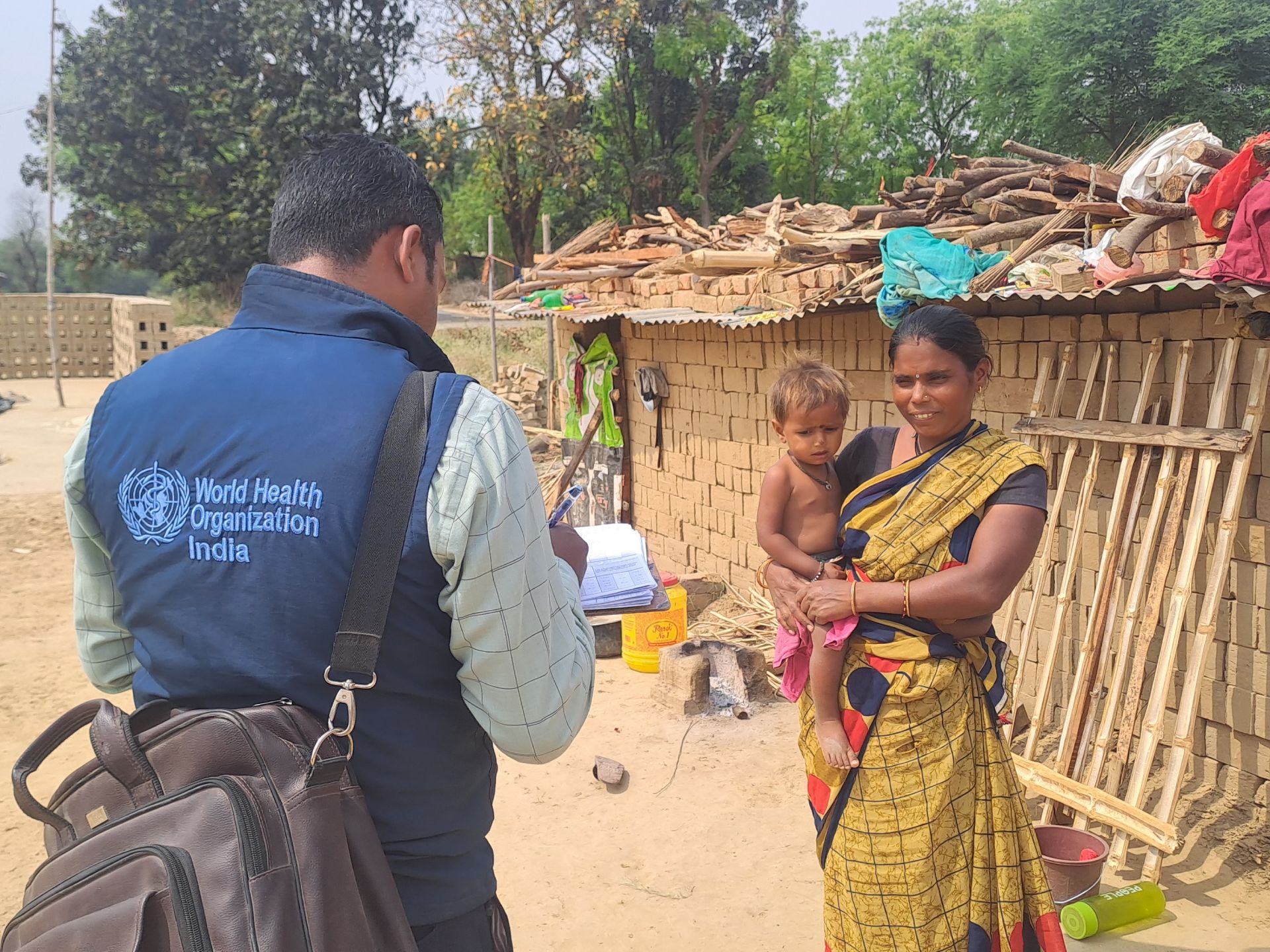
July 2024 | Prayagraj, Uttar Pradesh
A WHO officer conducting house-to-house monitoring in Kaundhiyara village in Prayagraj district to monitor the vaccination status of children under 5 years and report adverse events following immunization, if any. WHO field teams monitored 748 310 children vaccinated in 78 027 routine immunization sessions between January and May 2024 in Uttar Pradesh. (Photo: ©WHO India / Ritesh Sharma)
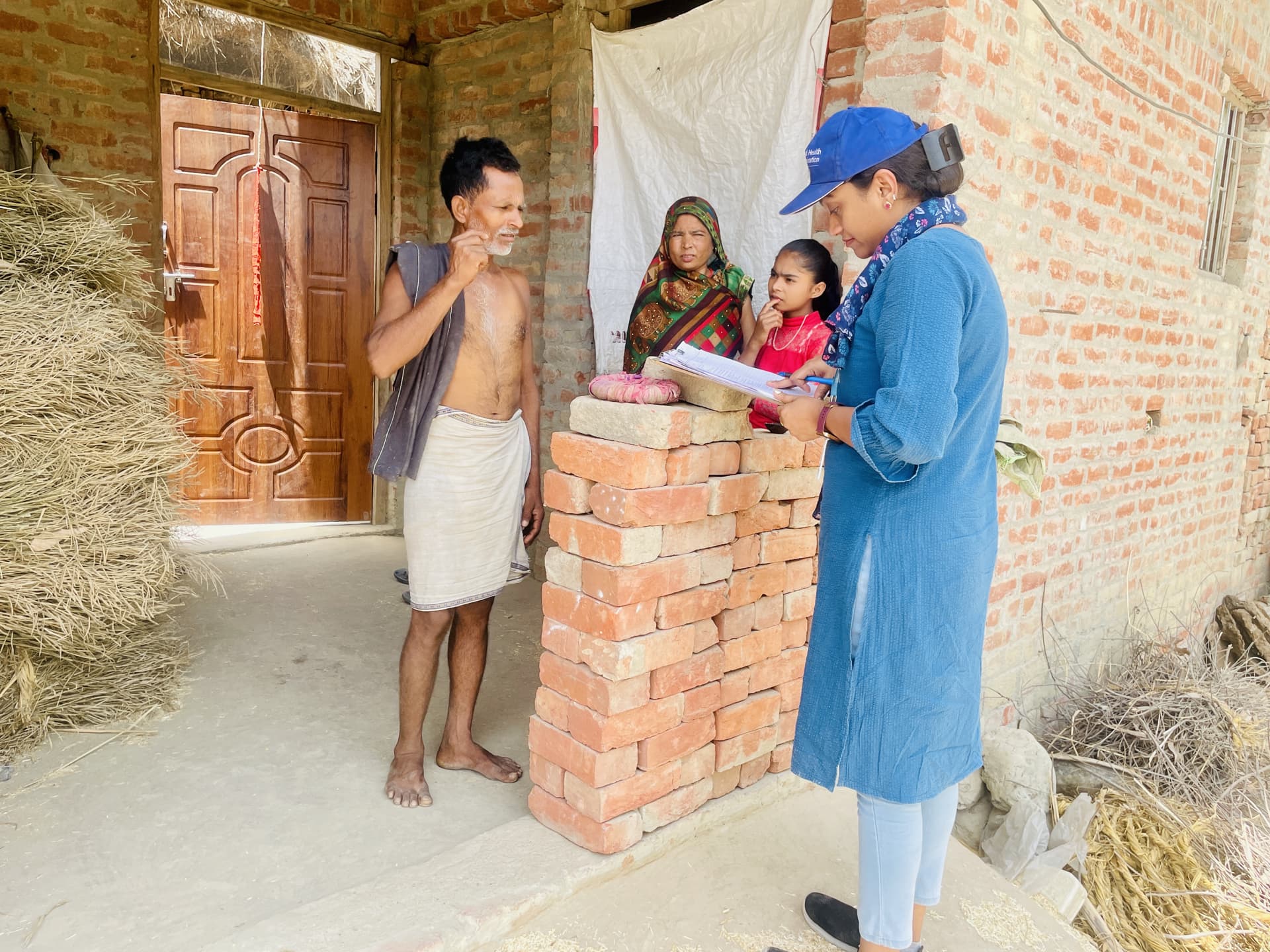
July 2024 | Hardoi, Uttar Pradesh
A WHO field officer conducting a house-to house-survey in the Tadiyawan block of Hardoi district during the Sanchari Rog Niyantran Abhiyan (communicable disease control campaign) in Uttar Pradesh. In April 2024, WHO teams covered 78 380 houses in 15 693 villages to assess the quality of the campaign in Uttar Pradesh. (Photo: © WHO India / Manoj Agnihotri)
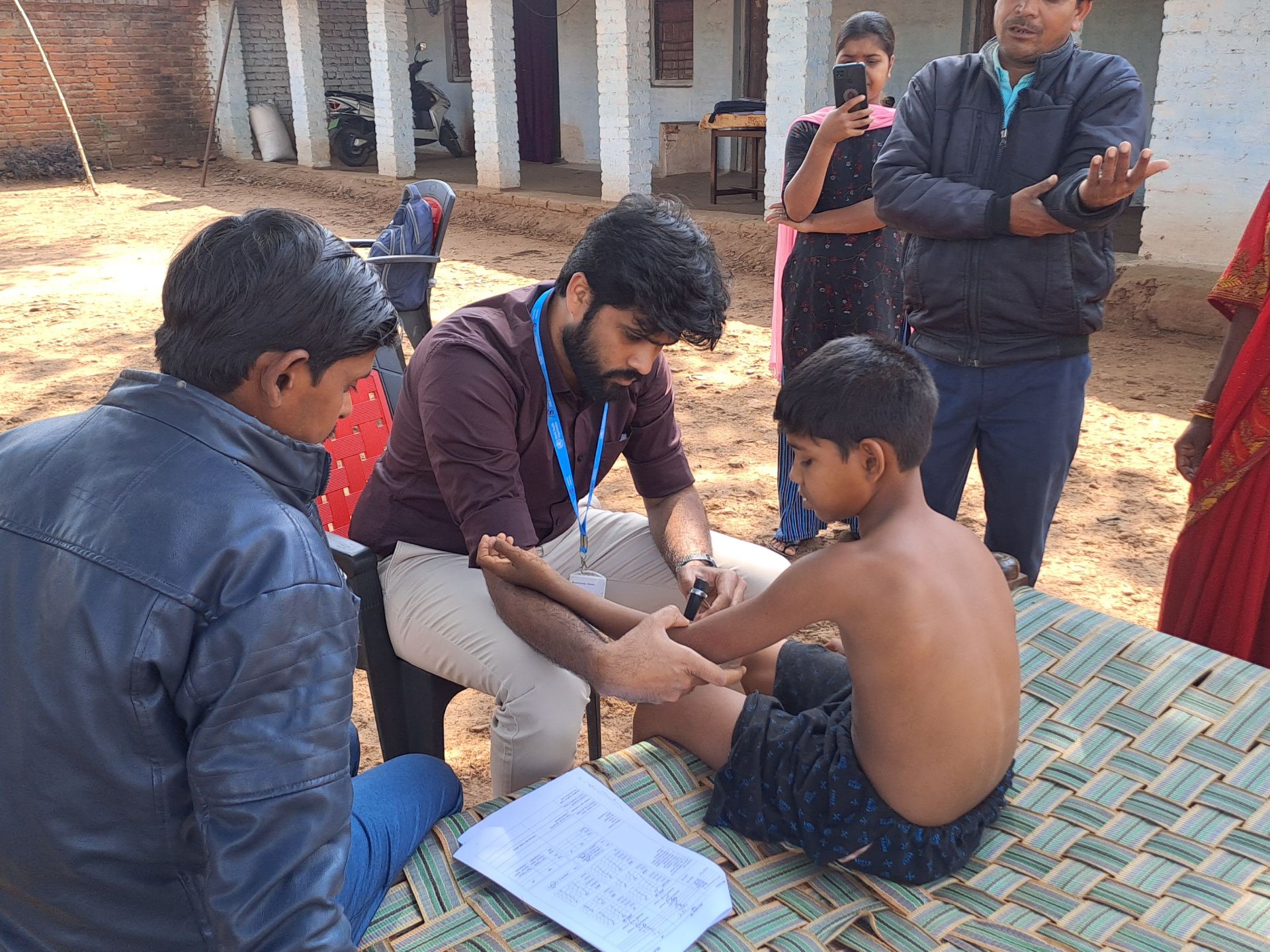
July 2024 | Sonbhadra, West Bengal
WHO teams conducting acute flaccid paralysis (AFP) case verification to rule out polio in Myorpur village in Sonbhadra district. AFP surveillance, supplemented by environmental surveillance of sewage samples, is critical to ensure India remains polio free. (Photo: © WHO India / Mohd. Aleem Ansari)
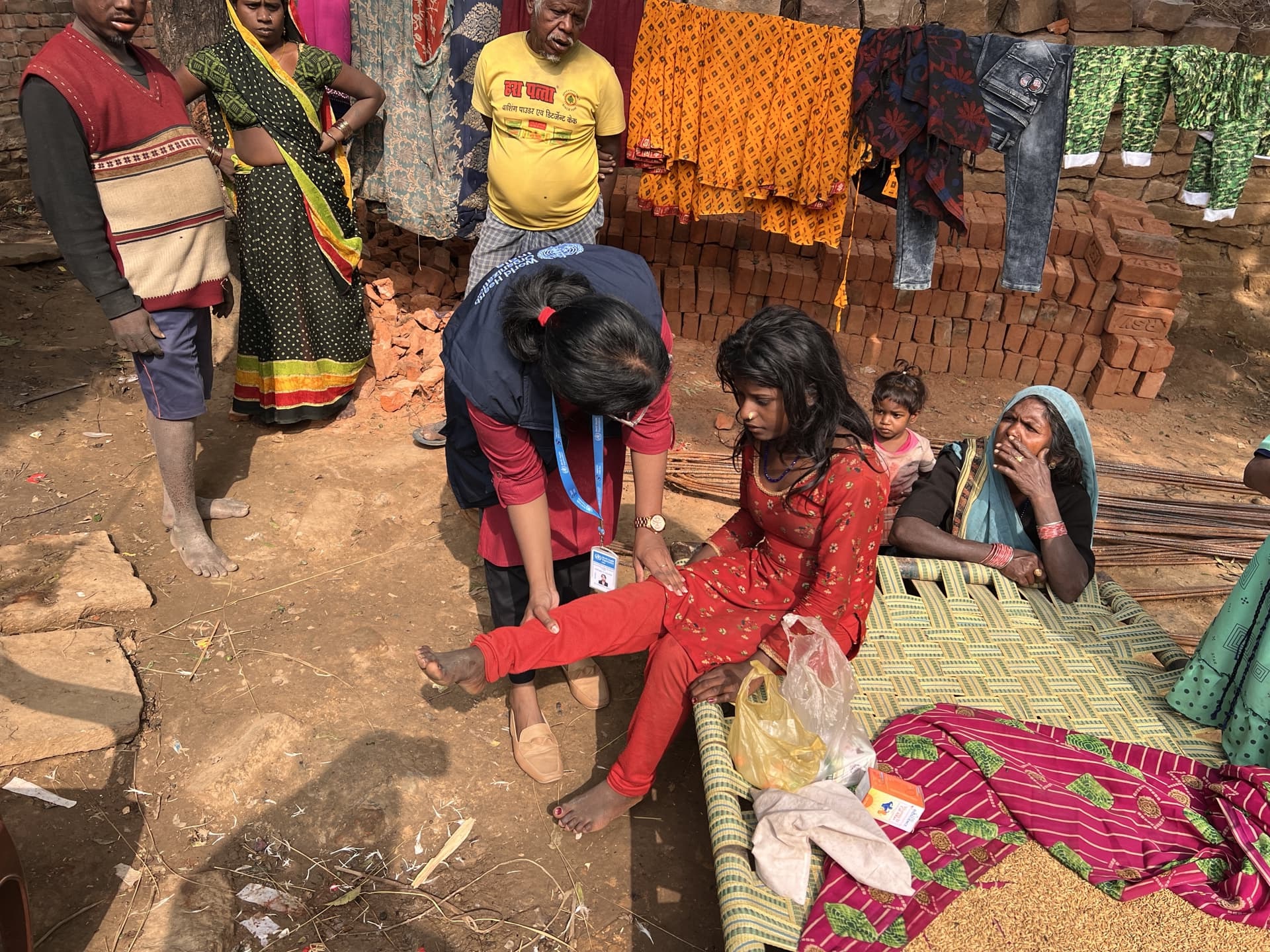
July 2024 | Chandauli, Uttar Pradesh
A WHO officer is conducting acute flaccid paralysis (AFP) case clinical examination to rule out polio in the Chakia block of Chandauli district in Uttar Pradesh. WHO investigated 3791 AFP cases reported between January and May 2024 in Uttar Pradesh and found high compliance to investigation and stool collection protocols. WHO conducts environmental surveillance at 13 sites for sewage sampling in 9 districts of Uttar Pradesh (Photo: © WHO India / Ajit Kumar Rao)
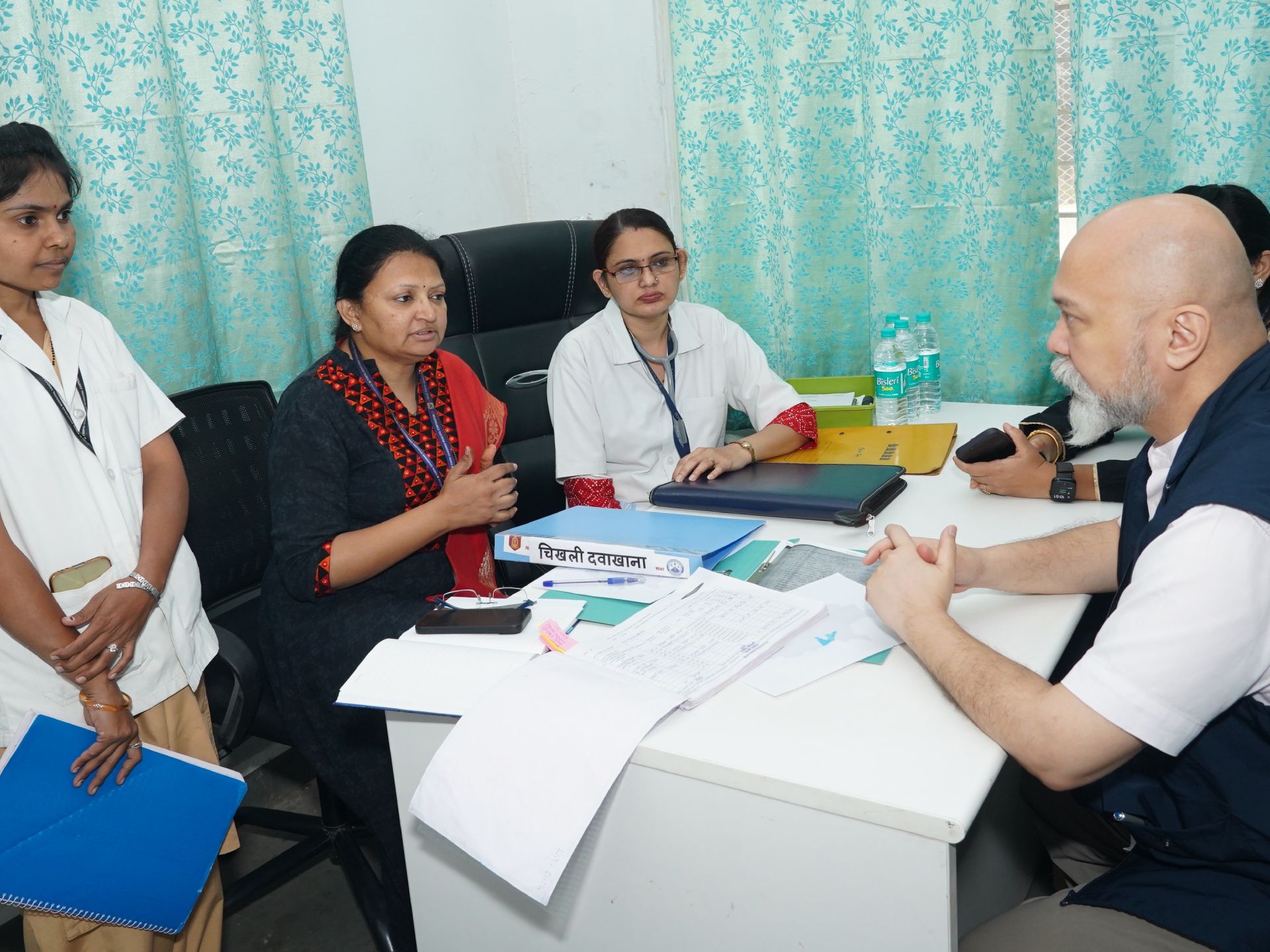
June 2024 | Pune, Maharashtra
WHO Representative to India Dr Roderico H. Ofrin discussing urban routine immunization microplanning with medical officers at Chikhali Urban Health and Wellness Centre under Pimpri Chinchwad Municipal Corporation in Pune. WHO provides technical and monitoring support to the Government of India for strengthening immunization services. (Photo: © WHO India / Sandeep Shirole)
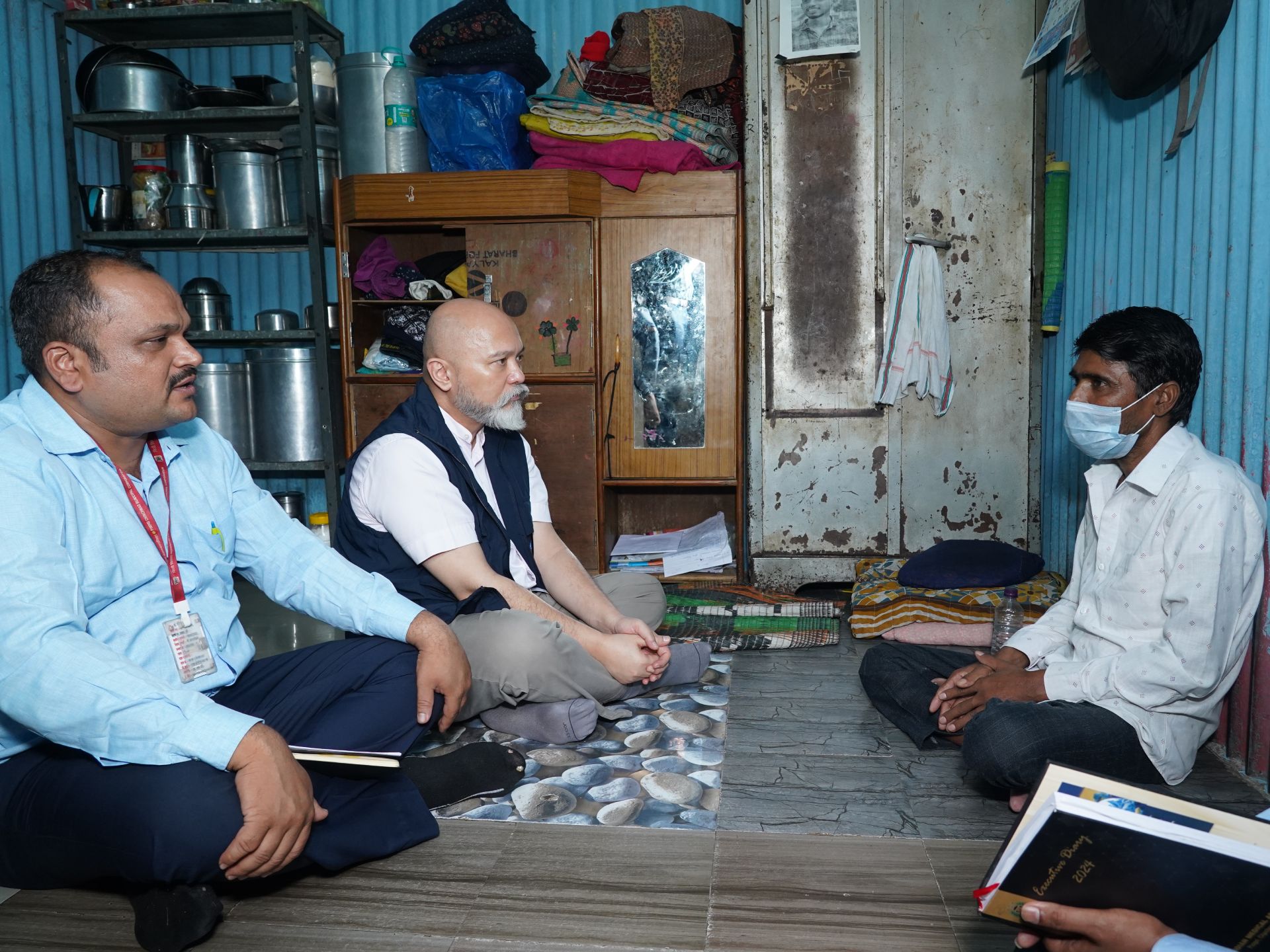
June 2024 | Pune, Maharashtra
WHO Representative to India Dr Roderico H. Ofrin visited Mr Vikram Dahije in his home in Ajantha Nagar, Pune, to discuss the quality to TB treatment and care services he has been receiving following TB diagnosis. Mr Dahije has completed four months of anti-TB treatment under the government programme. WHO provides technical support to the National TB Elimination Programme that provides free health care and social protection services to prevent, detect and treat tuberculosis to end TB in India. (Photo: © WHO India / Sandeep Shirole)
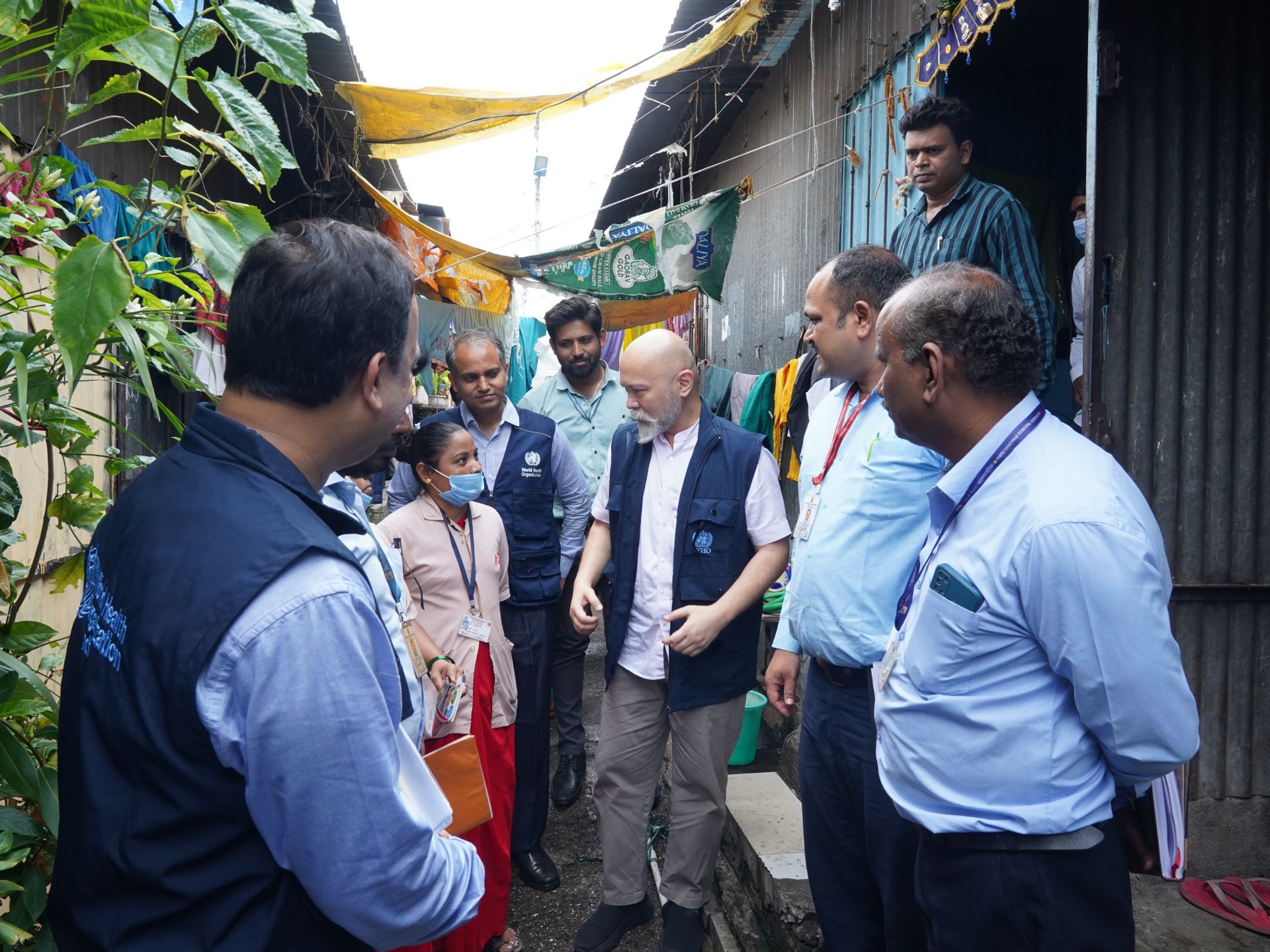
June 2024 | Pune, Maharashtra
ASHA worker Ms Radha Ingle briefing WHO Representative to India Dr Roderico H. Ofrin about her work in Ajantha Nagar, Pune. WHO provides technical support to the National TB Elimination Programme that provides free health care and social protection services to prevent, detect and treat tuberculosis to end TB in India. (Photo: © WHO India / Sandeep Shirole)

May 2024 | East Khasi Hills, Meghalaya
Mothers catch up after getting their children immunized at a session outreach clinic in Kenmynsaw Community Hall in Mawsynram, which receives the highest annual rainfall in the world. On other days, the community hall serves as a space for prayer, weddings, council meetings and theatre for the Khasi people. (Photo: © WHO India / Sanchita Sharma)
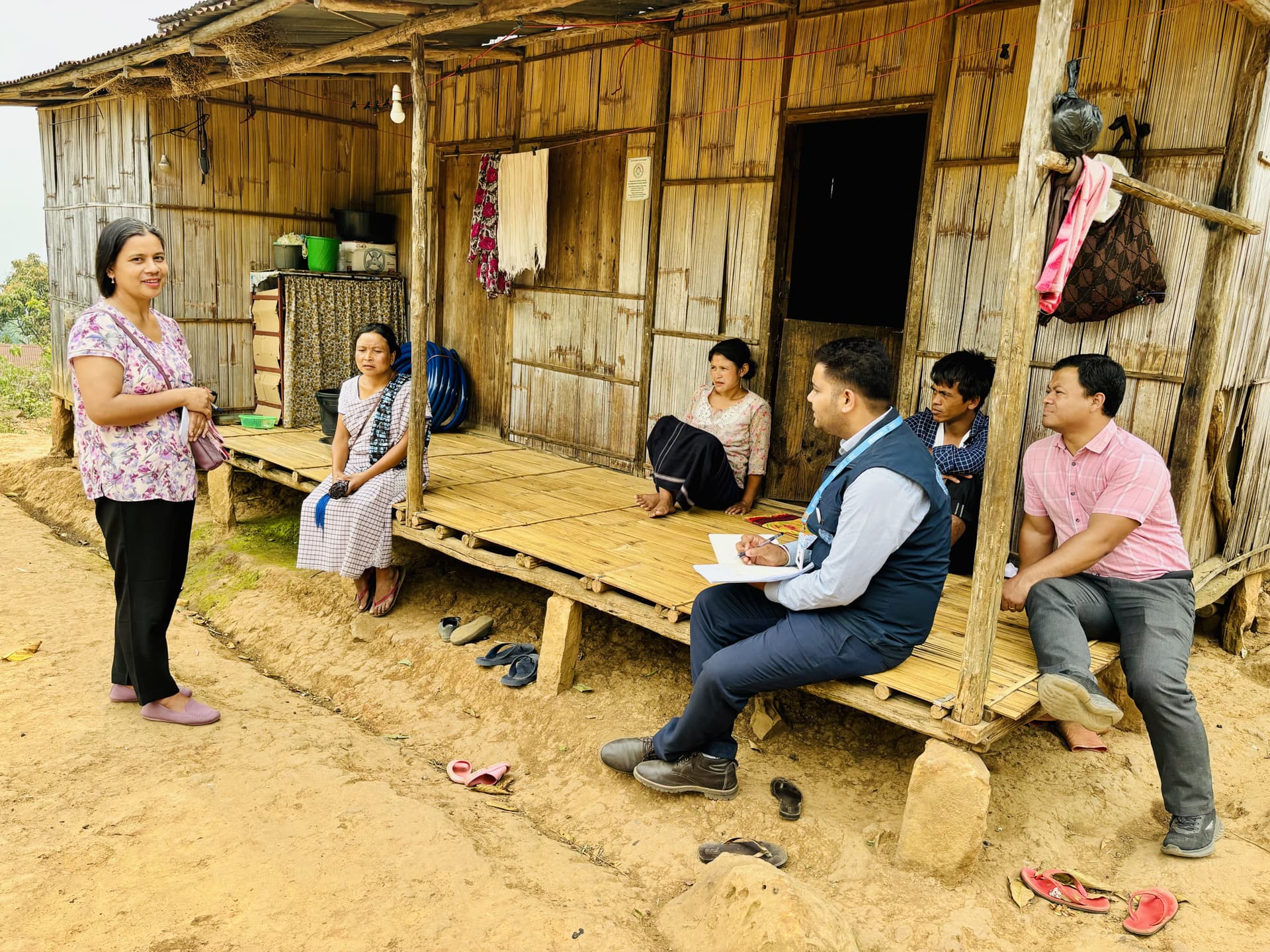
May 2024 | Ri Bhoi, Meghalaya
Dr Mariabiang K. Diengdoh (extreme right) with a WHO surveillance medical officer and his team from State Dispensary Umiam, update Ms. Enejuncy Sun about the primary health services available at monthly session sites in Lum sohpetbneng village in Ri Bhoi district. WHO provides technical and monitoring support to the Government of India for strengthening immunization services, with a focus on remote areas. (Photo: © WHO India / Sanchita Sharma)
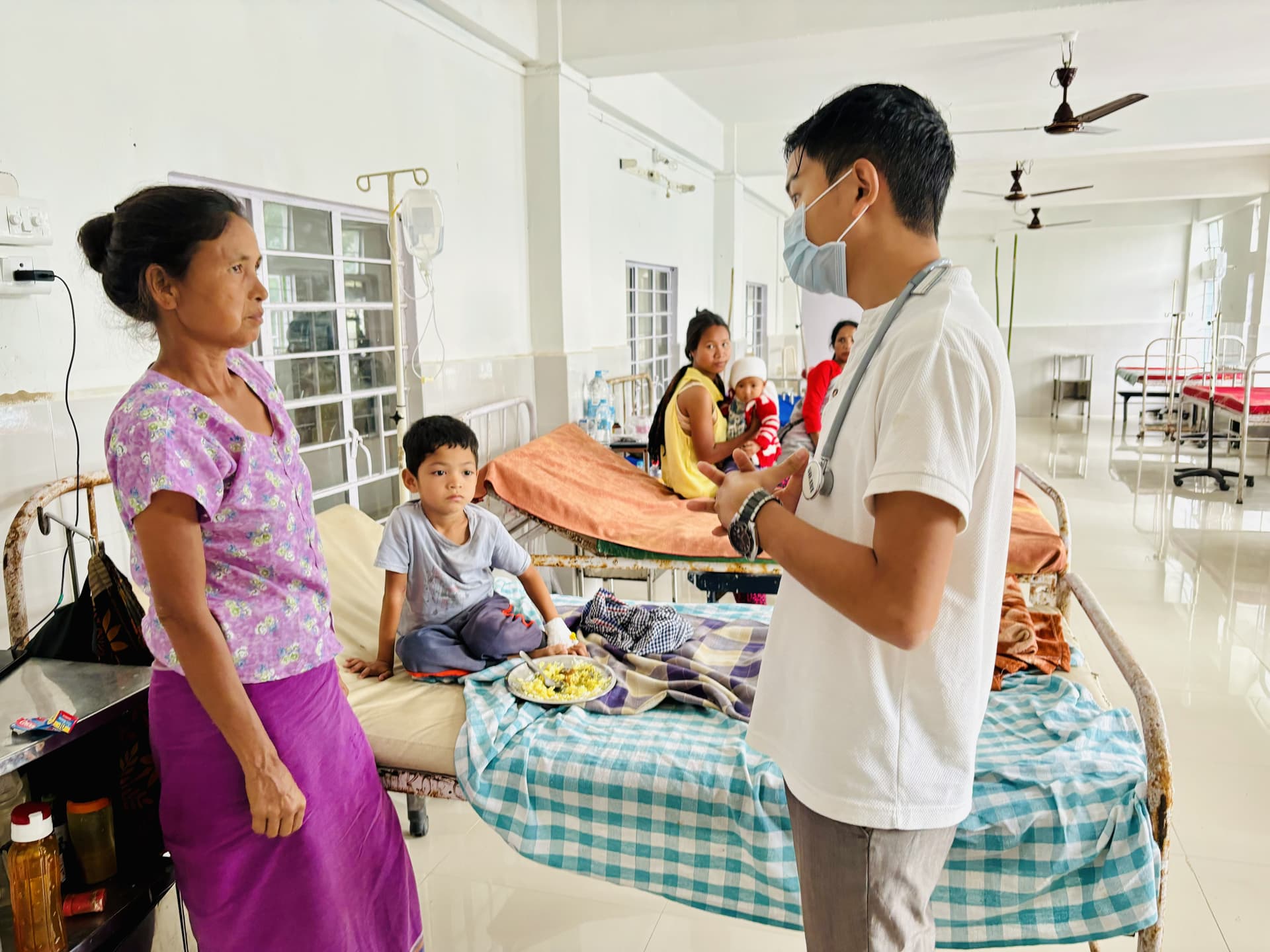
May 2024 | South West Khasi Hills, Meghalaya
Dr K. Mawlong shares Ida’s Nomgplahangi’s health update with his mother Ms Ishuwayaka Nomgplahangi. Iba was admitted with fever three days ago to the general ward in Ranikor Community Health Centre bordering Bangladesh and is now set to be discharged. (Photo: © WHO India / Sanchita Sharma)
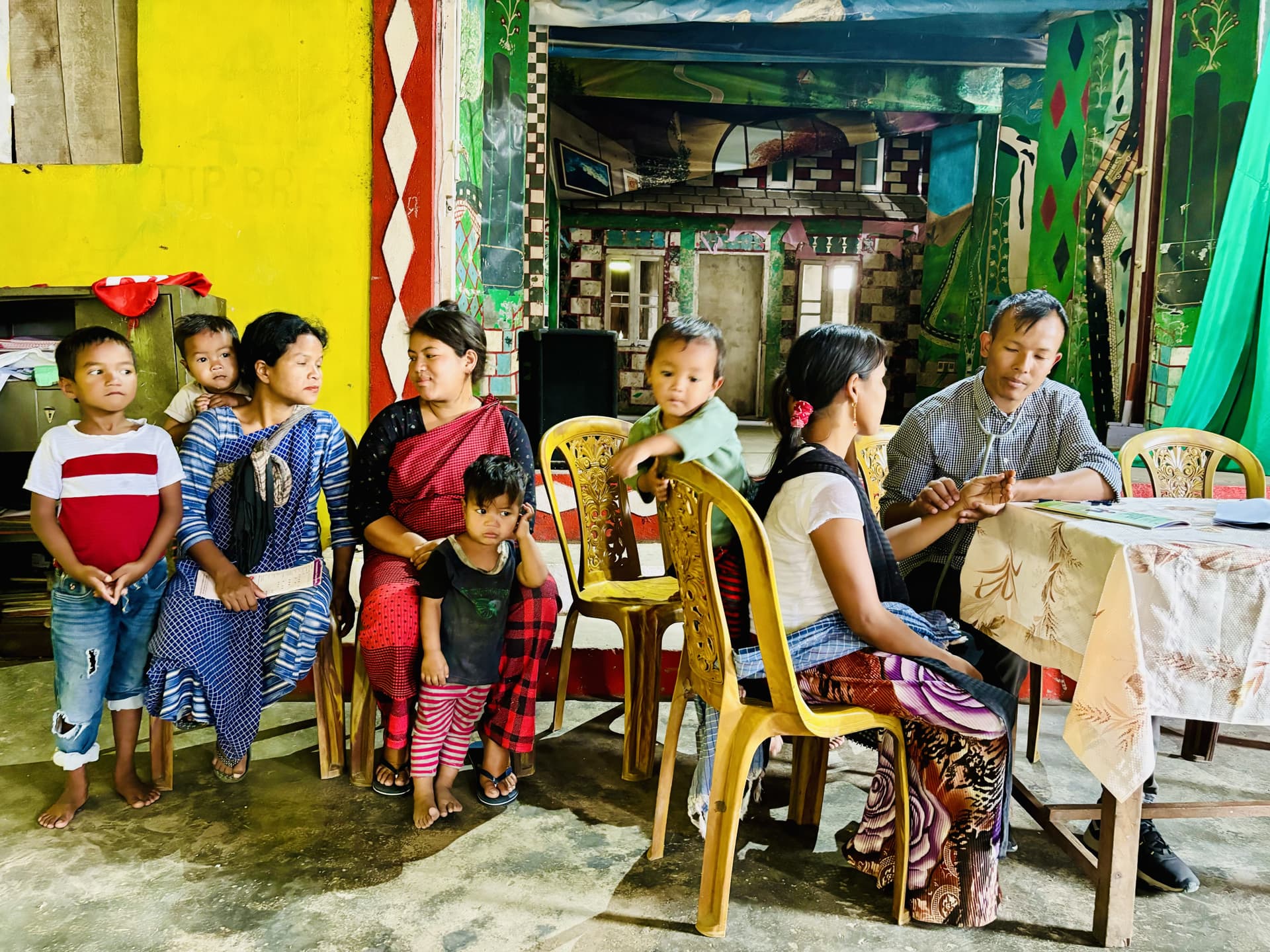
May 2024 | East Khasi Hills, Meghalaya
Women waiting to get their children immunized in an outreach session site in Kenmynsaw village in Mawsynram. Such outreach sessions are a lifeline for communities in the wet season from May to October, when torrential rains isolate villages in this hilly region. WHO provides technical and monitoring support to the Government of India for strengthening health services. (Photo: © WHO India / Sanchita Sharma)
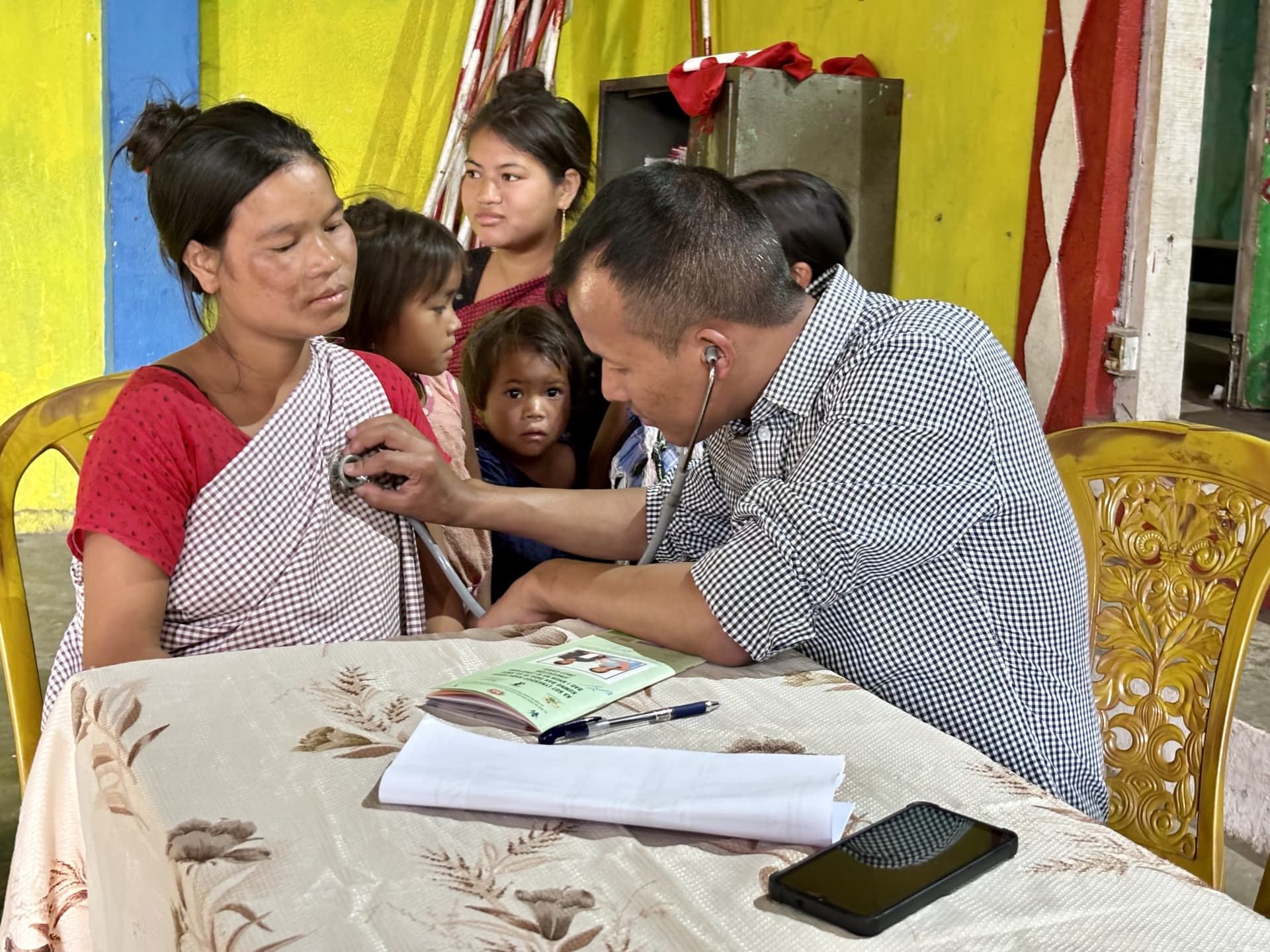
May 2024 | East Khasi Hills, Meghalaya
Dr R. Suchiang, medical officer, Mawsynram Community Health Centre, conducting a routine checkup of Ms Thianghun Langpen, 35, at an outreach health clinic in Kenmynsaw village in Mawsynram. Ms Langpen has six children. (Photo: © WHO India / Sanchita Sharma)
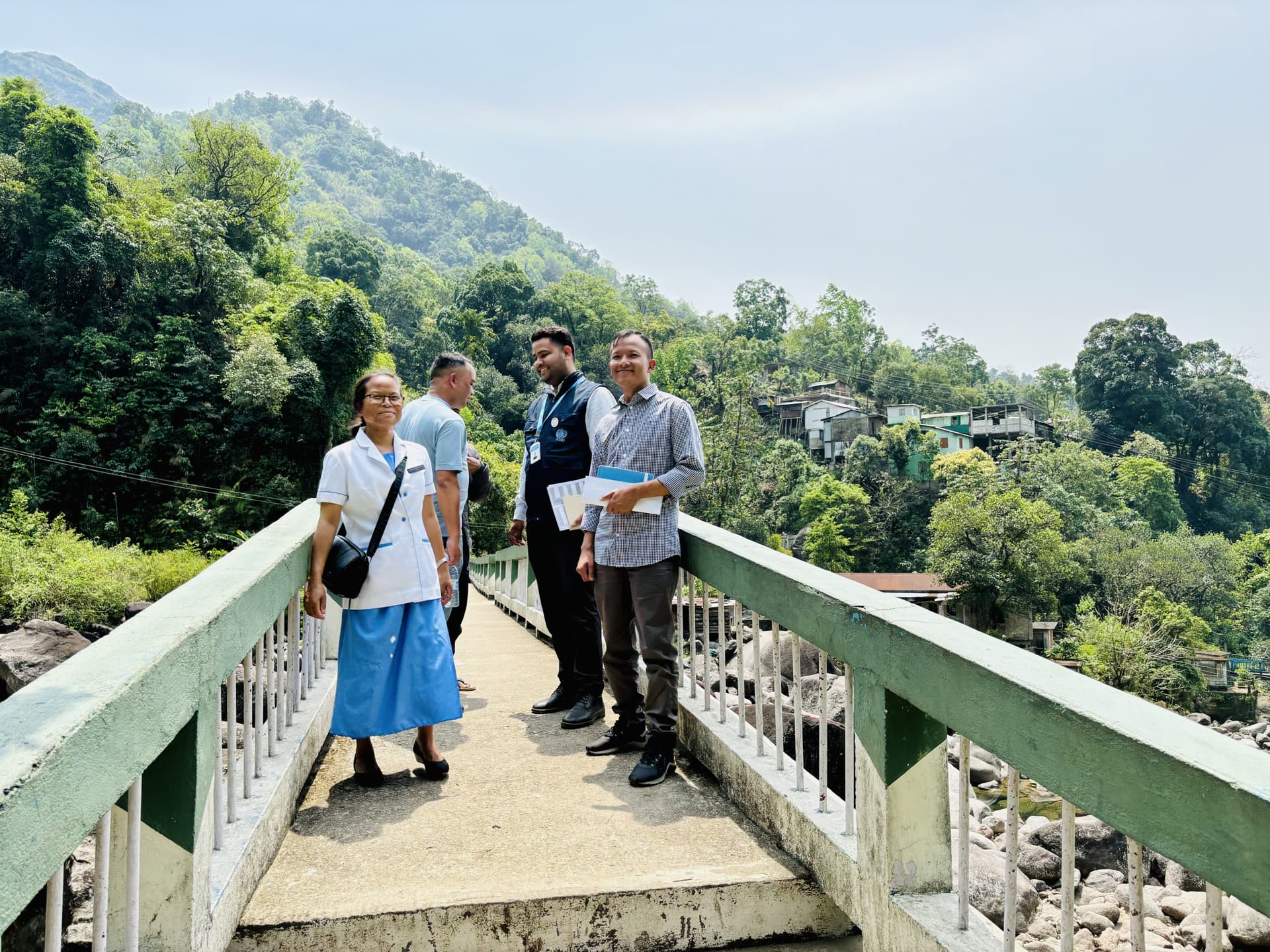
May 2024 | East Khasi Hills, Meghalaya
A WHO surveillance medical officer accompanies the health workforce from Mawsynram Community Health Centre to a health outreach clinic in Kenmynsaw village. Mawsynram is the wettest place in the world, and outreach clinics become a lifeline for communities in the wet season from May to October. WHO provides technical and monitoring support to the Government of India for strengthening immunization services. (Photo: © WHO India / Sanchita Sharma)
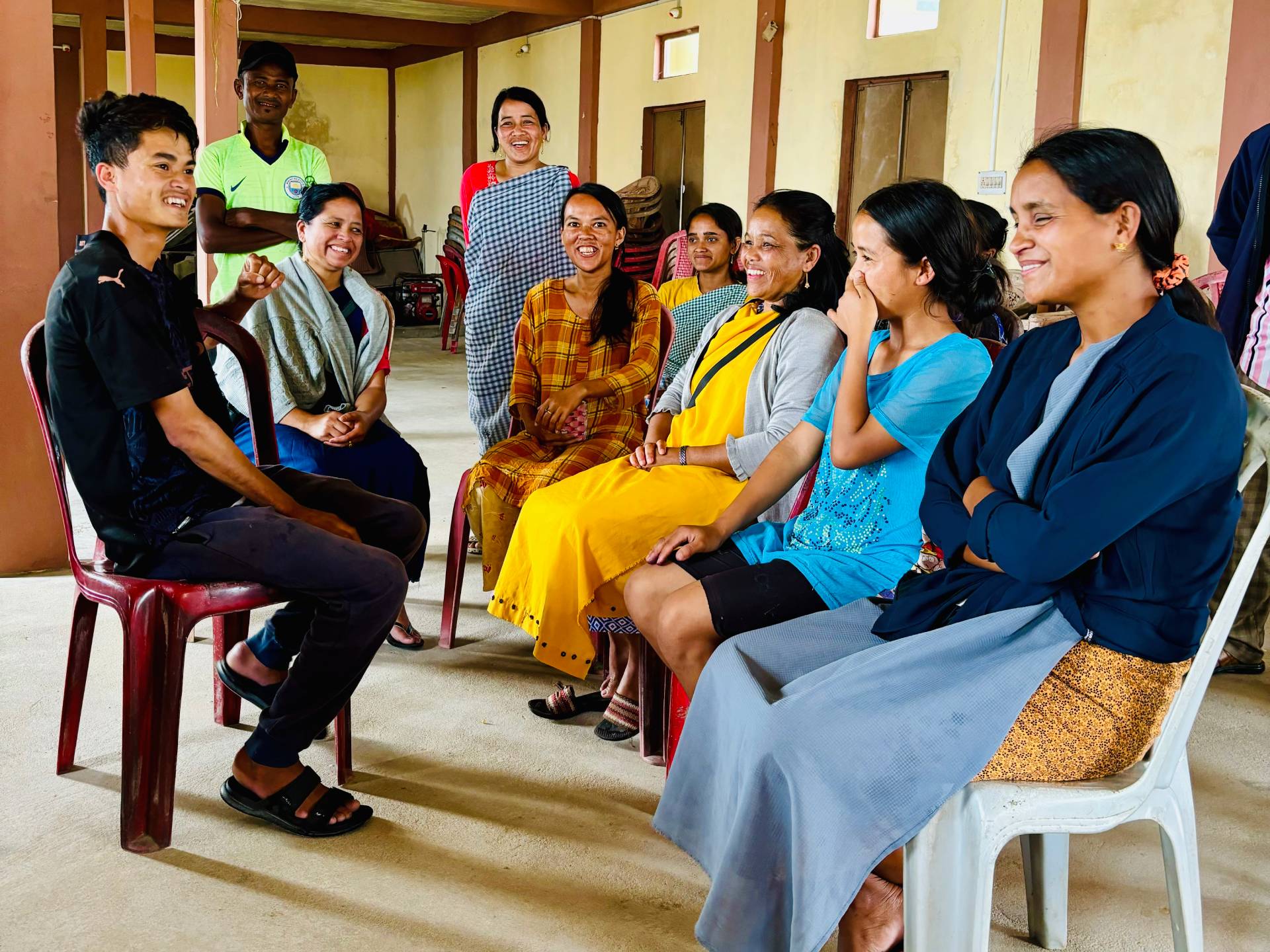
May 2024 | East Khasi Hills, Meghalaya
Mawtepiew Village Health Council chaired by the village headman Mr Lukas Kharwar appointed local football hero Mr John Evanmajaw, 22, (extreme left) as a Tobacco Free Nodal Officer to convince young people to say no to areca nut and yes to health. Areca nut (kwai in Khasi language) is addictive and carcinogenic. it is widely cultivated in East Khasi hills and consumed in fresh, cured and dry forms by people across gender and age. Offering kwai to welcome visitors is a local tradition that Mr Evanmajaw is persuading the youth in his community to abandon. (Photo: © WHO India / Sanchita Sharma)

April 2024 | East Khasi Hills, Meghalaya
Pregnant women wait after their health check-up at a session outreach site organized by Mawsynram Community Health Centre in their village’s Kenmynsaw Community Hall in Mawsynram, which receives the highest annual rainfall in the world. on other days, Kenmynsaw Community Hall serves as a space for prayer, weddings, council meetings and theatre for the Seng Khasi people. WHO provides technical and monitoring support to the Government of India for strengthening immunization services. (Photo: © WHO India / Sanchita Sharma)
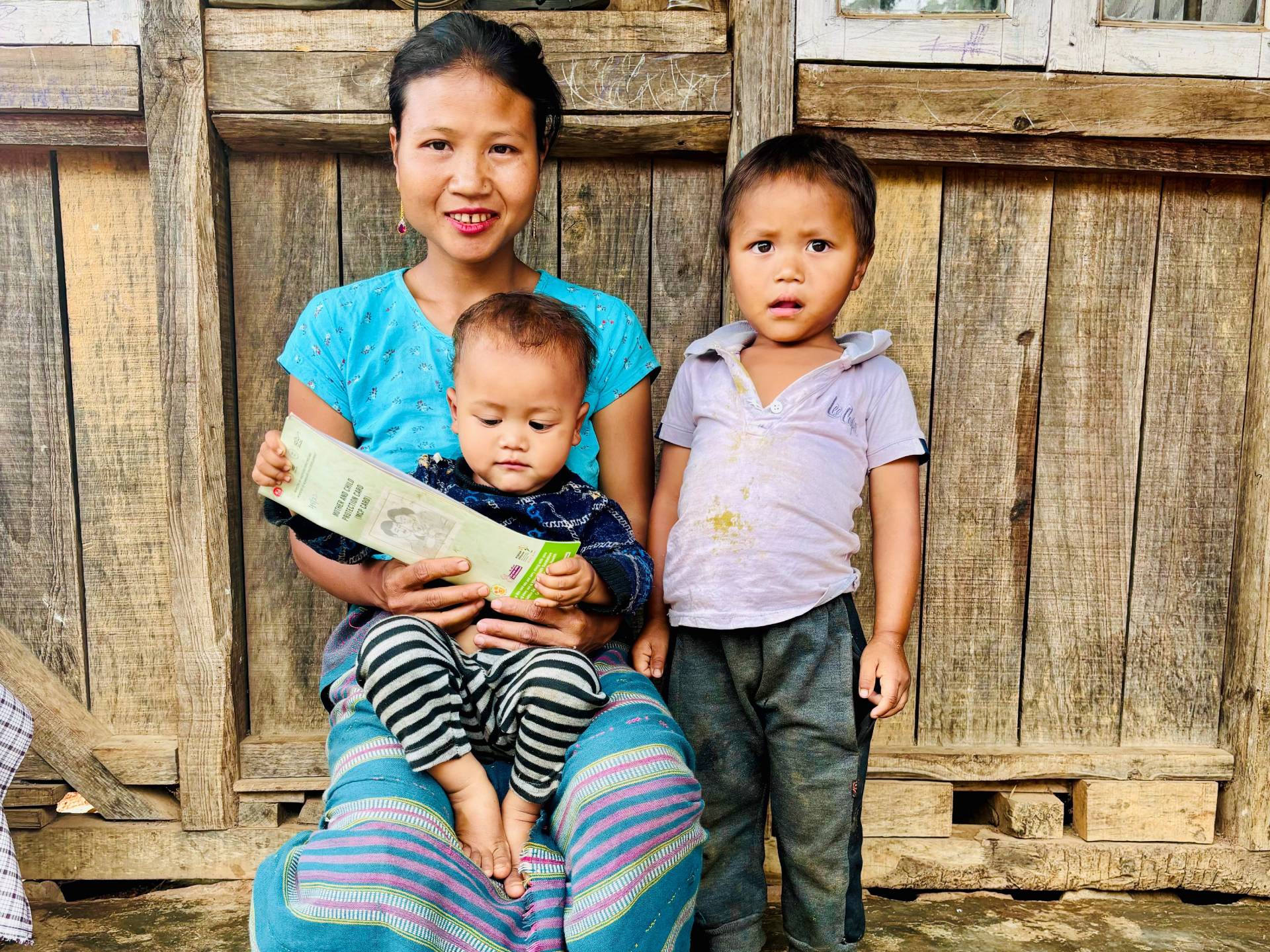
April 2024 | Ri Bhoi, Meghalaya
Ms. Sbian Kurbah’s youngest son Batskhemlang (holding his immunization card) was born at home in Lum sohpetbneng village in Meghalaya like his three siblings. But unlike them, he received timey immunization because the health workforce from State Dispensary Umiam, Ri Bhoi, addressed the family’s vaccine hesitancy concerns. WHO provides technical and monitoring support to the Government of India for strengthening immunization services, with a focus on remote areas. (Photo: © WHO India / Sanchita Sharma)
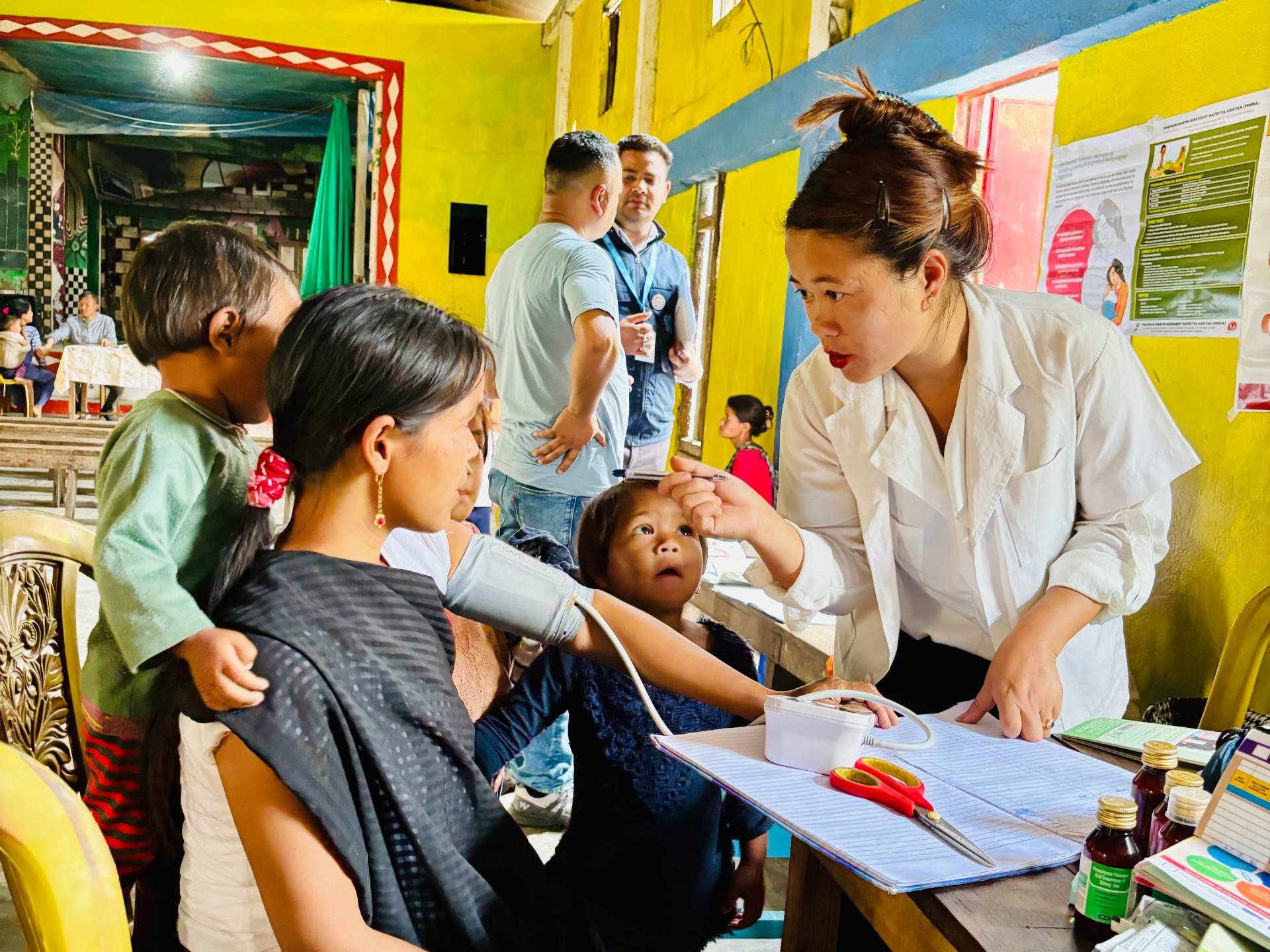
April 2024 | East Khasi Hills, Meghalaya
An auxiliary nurse midwife measures the blood pressure of a pregnant woman at an outreach health clinic in Kenmynsaw village in the Mawsynram subdivision of the East Khasi Hills district. Under India’s 75/25 initiative, 75 million people will be provided free treatment for hypertension and diabetes by 2025. (Photo: © WHO India / Sanchita Sharma)
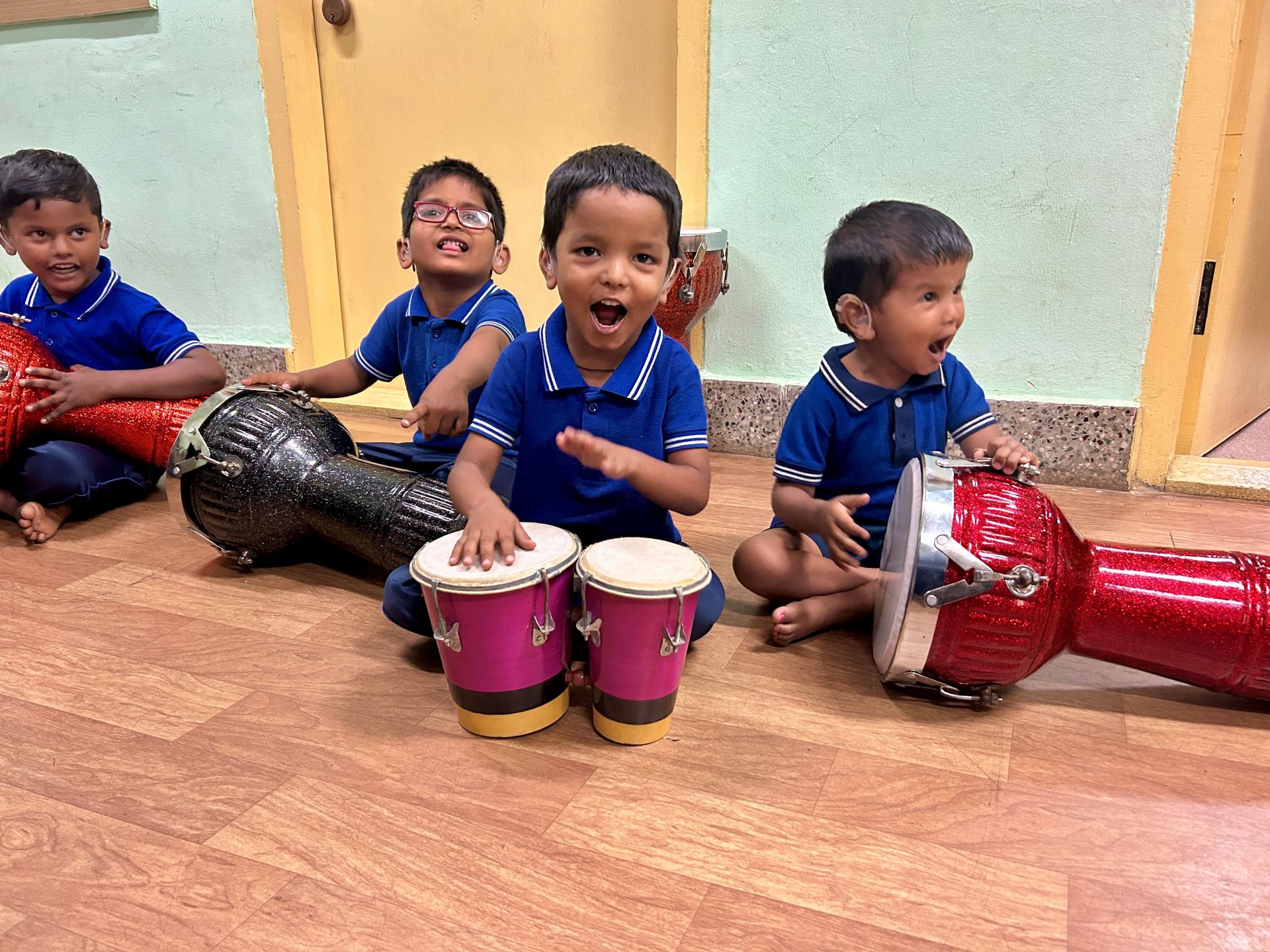
March 2024 | Mysuru, Karnataka
Creative expression through music for the holistic development of children with communication disorders is part of the Special Use of Music for Educational Readiness and Upbuilding (SUMERU) initiative of the Department of Special Education, All India Institute of Speech and Hearing in Mysuru, Karnataka. (Photo: © WHO India / Anshu Shekhar Roy)
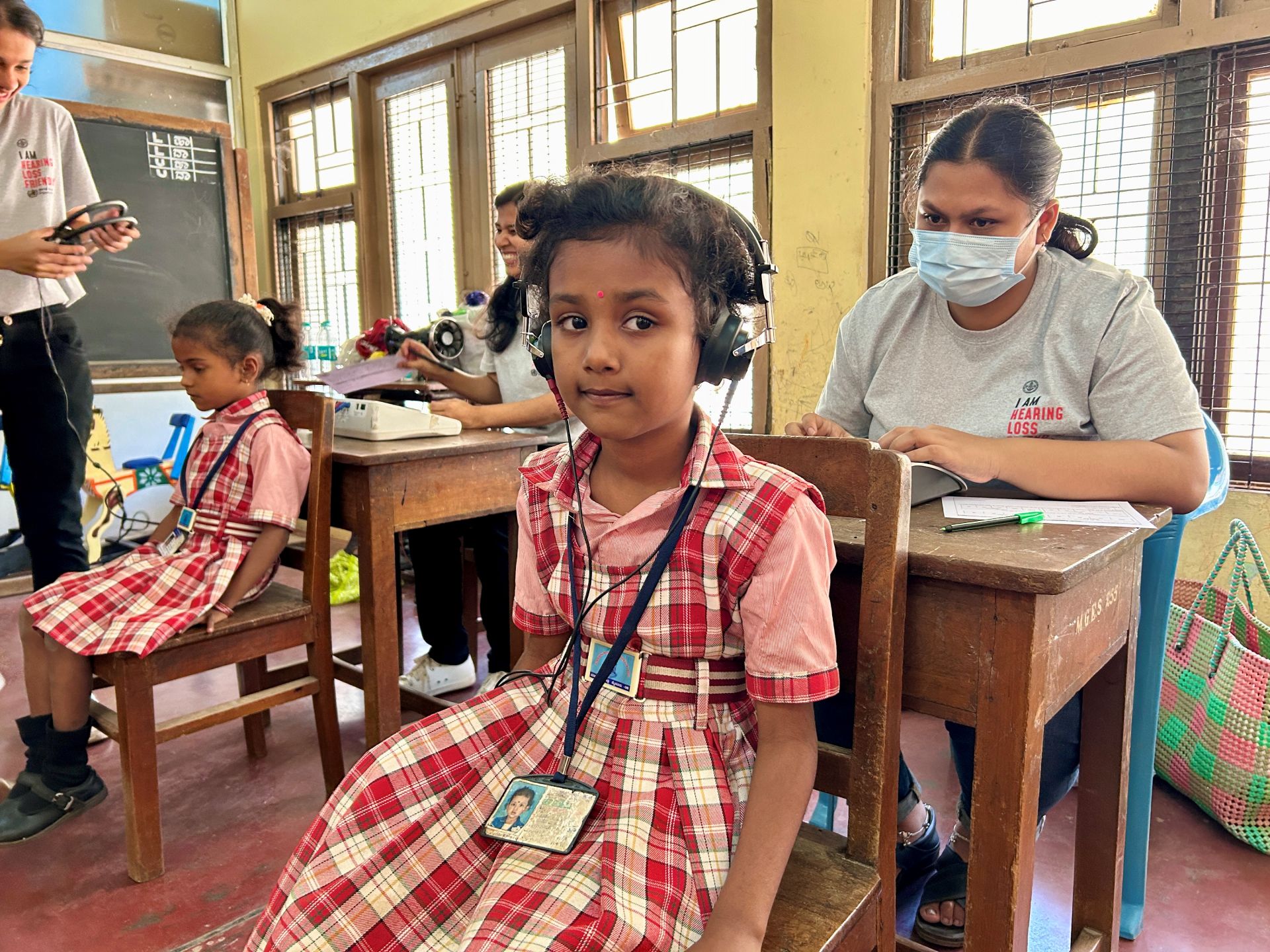
March 2024 | Mysuru, Karnataka
Trained audiologists and ENT surgeons assessed the ear and hearing health of 1200 students in four schools in Mysuru under an All India Institute of Speech and Hearing initiative supported by WHO. (Photo: © WHO India / Anshu Shekhar Roy)
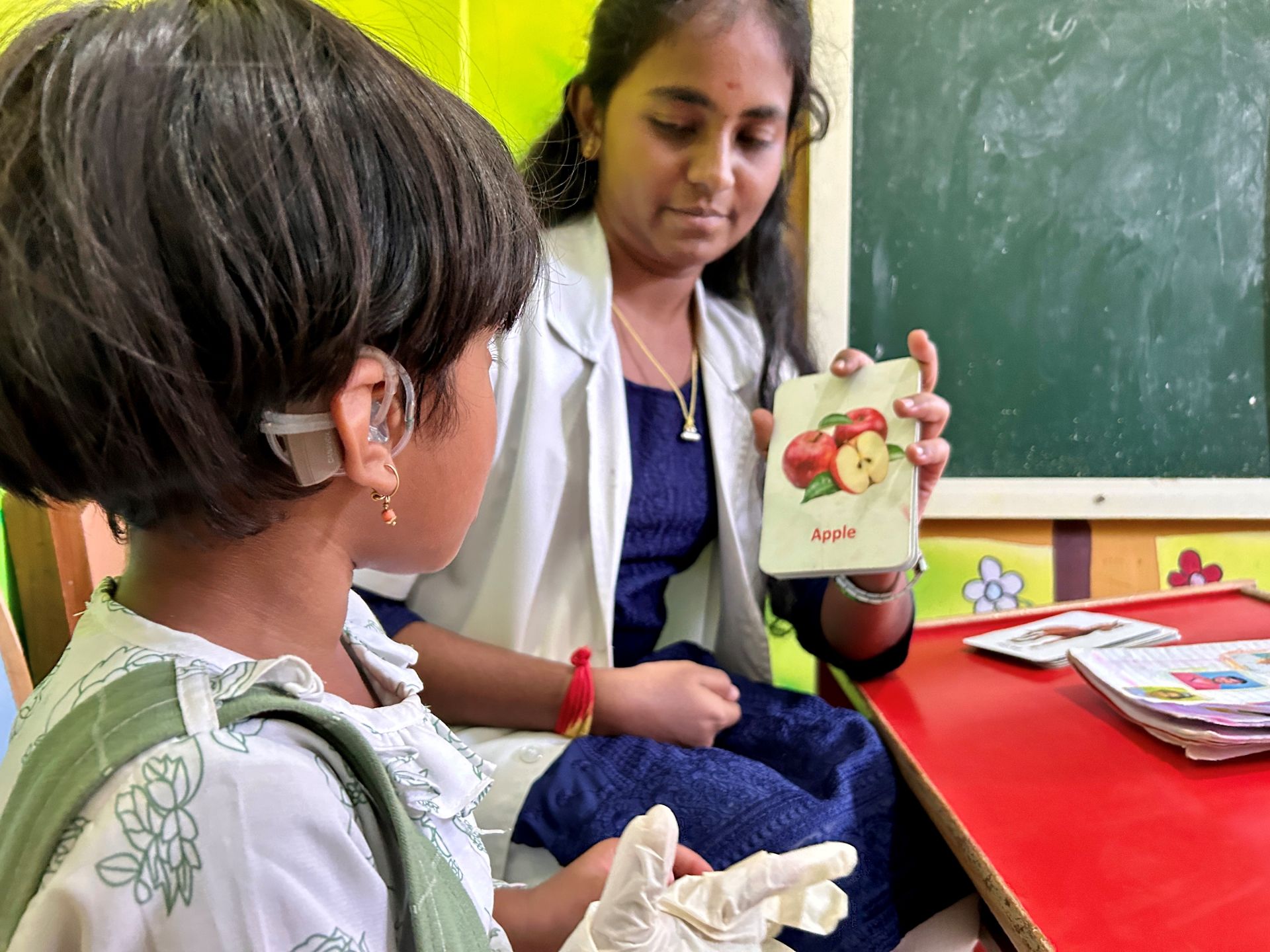
March 2024 | Mysuru, Karnataka
A pre-schooler with hearing impairment undergoing speech and listening therapy. Over 1.5 billion people live with ear problems and hearing loss globally; another one billion are at risk of hearing loss from unsafe listening practices. (Photo: © WHO India / Anshu Shekhar Roy)
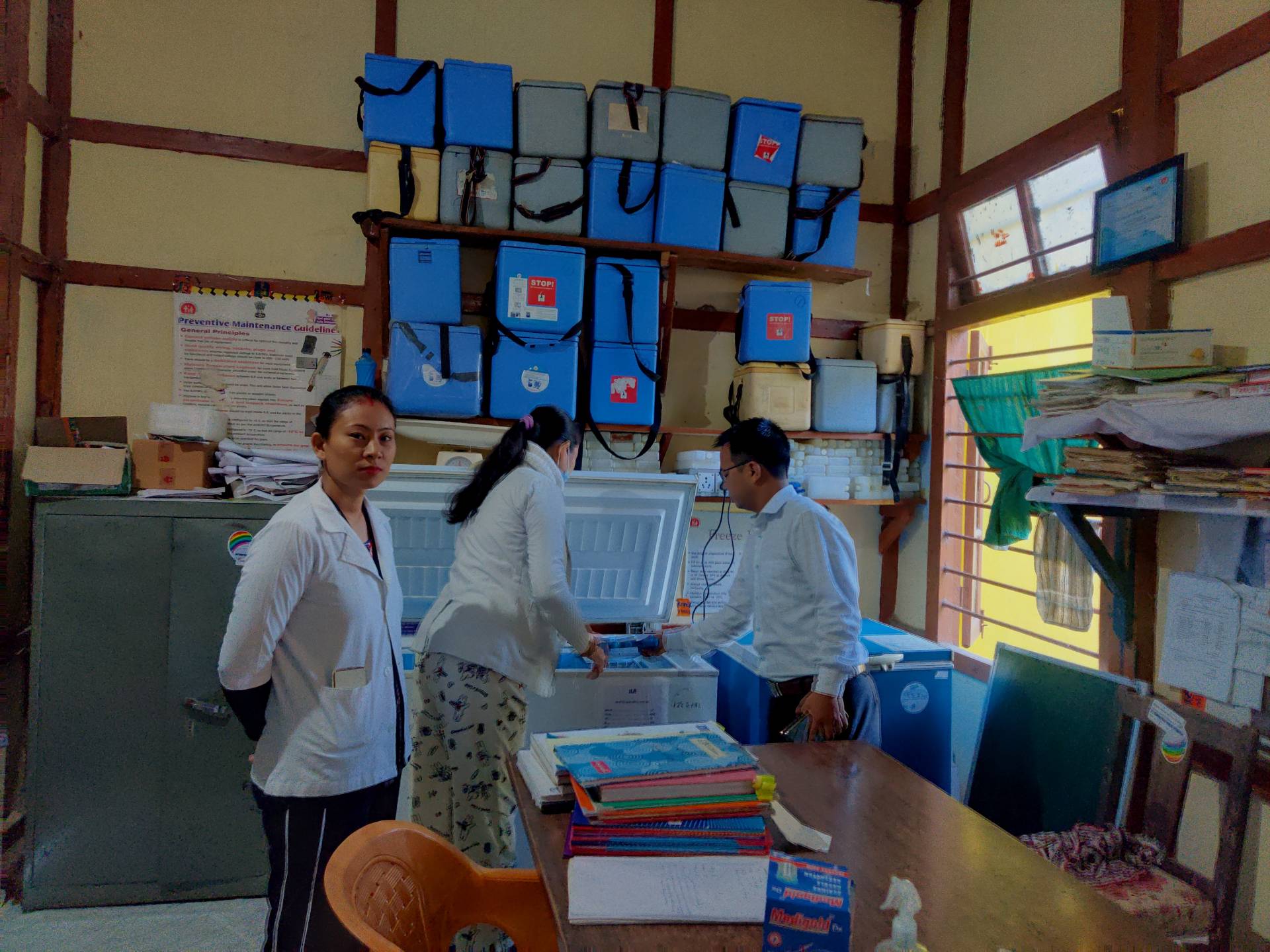
January 2024 | Longding, Arunachal Pradesh
Dr T Wangshu (extreme right) and auxiliary nurse midwives Ms Lipi Pegu and Ms Jimi Mech carry vaccines and essential medicines from Community Health Centre Kanubari, Longding district, to deliver health services to communities living in remote and hard-to-reach areas. WHO provides technical and monitoring support to Government of India in strengthening routine immunization and primary health services. (Photo: © WHO India / Sanchita Sharma)
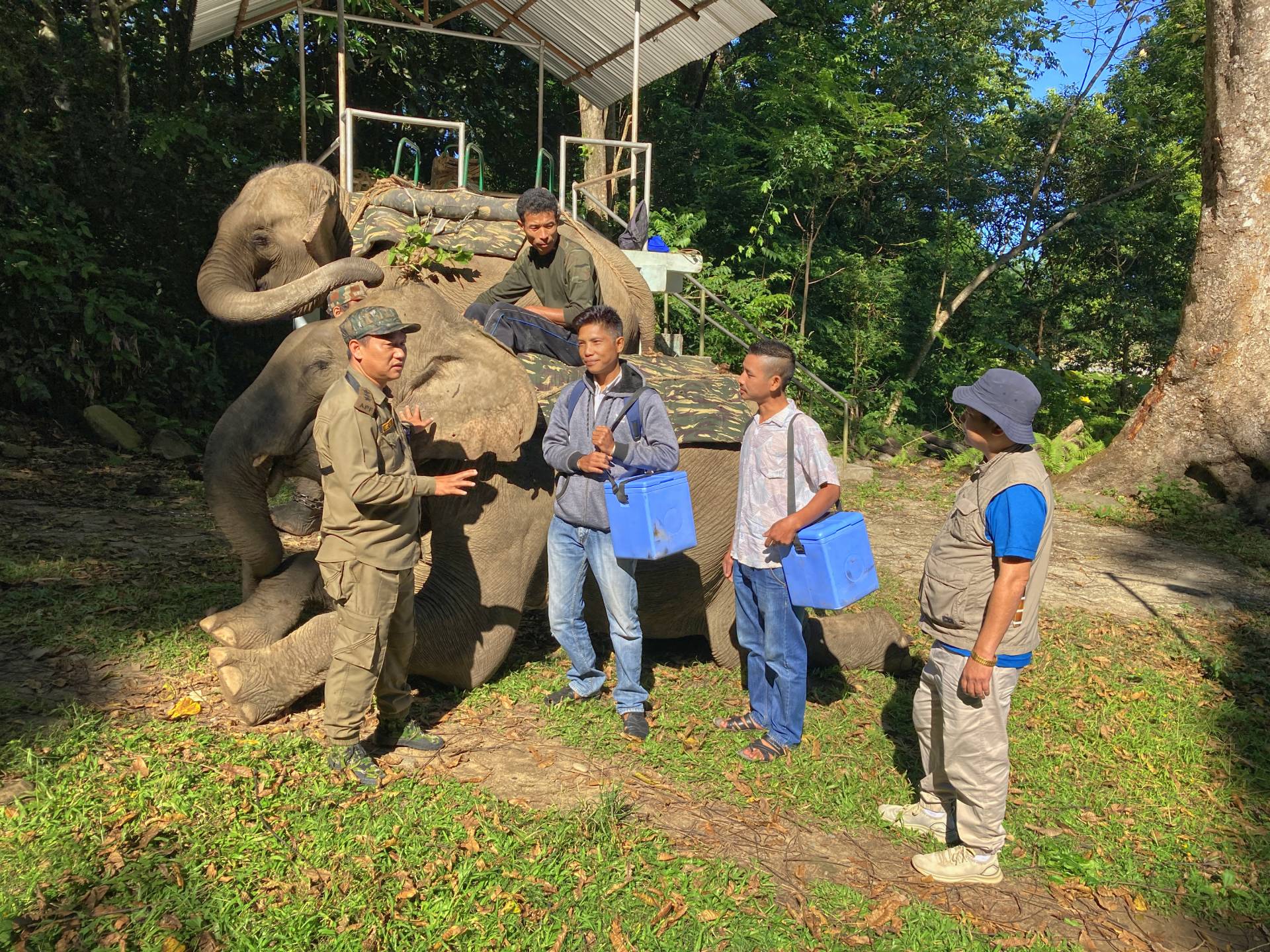
January 2024 | Changlang, Arunachal Pradesh
Mr Tage Mali (extreme left), forest officer, Miao circle, Namdapha National Park and Tiger Reserve, and Dr Jongsam Handsome (extreme right), medical officer in-charge, Miao sub-division, Changlang district, brief vaccinators before they begin their elephant ride across the Noa-Dihing river to Ayushman Bharat Health and Wellness Centre Deban. The elephant Lakhi sits patiently with her nephew Samraj, 13, who is getting ready to head off for forest patrolling. (Photo: © WHO India / Sanchita Sharma)
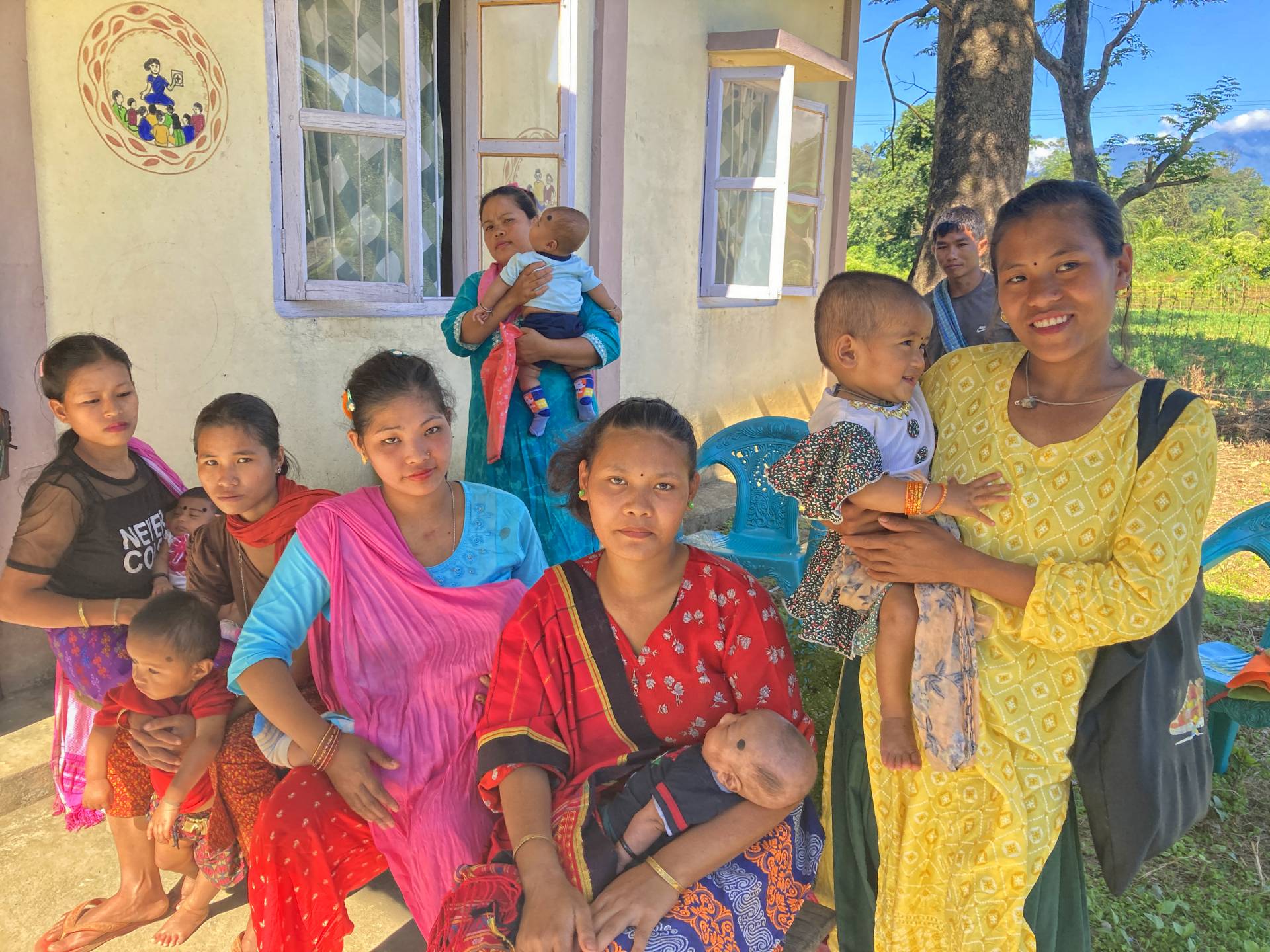
January 2024 | Changlang, Arunachal Pradesh
Mothers wait their turn to get their children immunized at Ayushman Bharat-Health and Wellness Centre Deban. WHO National Public Health Support Network (NPSN) provides technical and monitoring support for routine immunization and vaccine-preventable diseases to the Government of India, with special focus on strengthening services in hard-to-reach areas. Under the Government of India’s Universal Immunization Programme, close to 2.67 crore children and 2.9 crore pregnant women are immunized free of cost against 12 vaccine-preventable disease annually. (Photo: © WHO India / Sanchita Sharma)
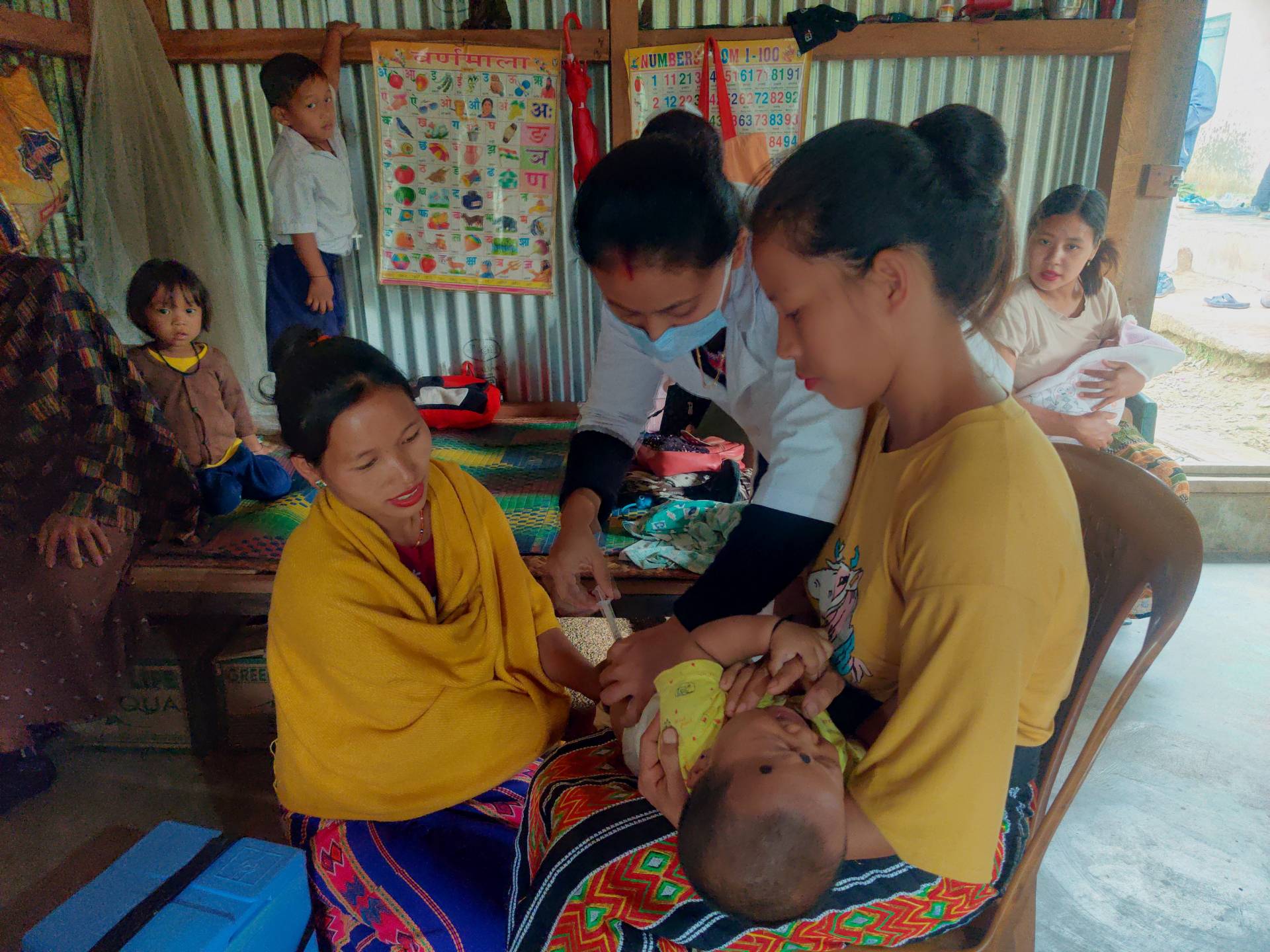
January 2024 | Longding, Arunachal Pradesh
An auxiliary nurse midwife from Community Health Centre Kanubari, Longding district, Arunachal Pradesh, vaccinates a baby in a makeshift immunization clinic for women and children in the hard-to-reach Chopnu village in Tirap district, Arunachal Pradesh. WHO National Public Health Support Network (NPSN) provides technical and monitoring support to strengthen routine immunization and vaccine-preventable diseases to the Government of India with special focus on strengthening services in hard-to-reach areas. (Photo: © WHO India / Sanchita Sharma)
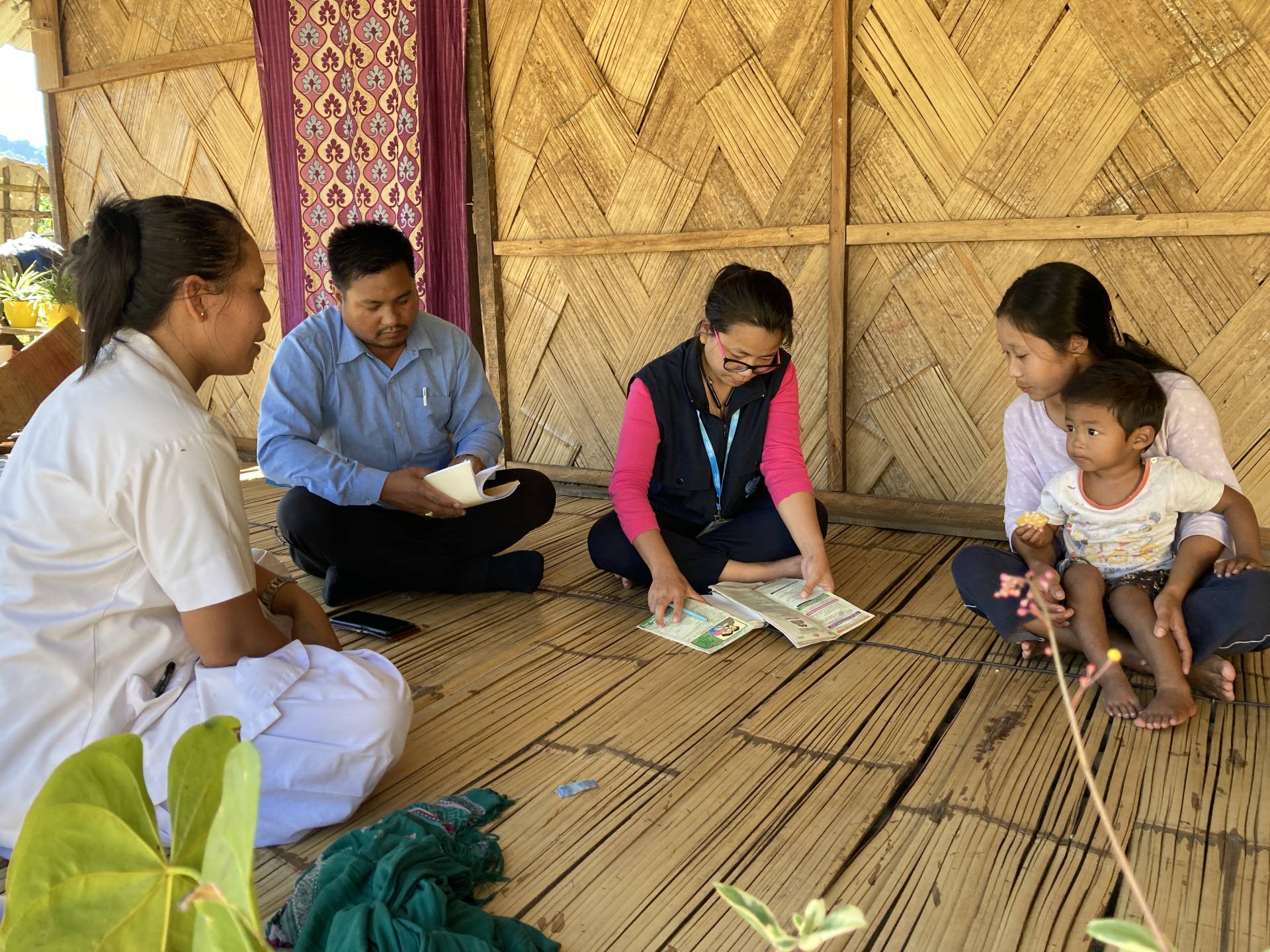
January 2024 | Changlang, Arunachal Pradesh
The WHO National Public Health Support Network (NPSN) team from Namsai supports auxiliary nurse midwife Ms Sincha Tikhak (in white) review Ms Hamnon Mossang’s son Khimthoi’s (born 24 April 2021) immunization card in their home in the remote Lungpang village in Changlong district, Arunachal Pradesh, India. WHO NSPN provides technical and monitoring support for routine immunization and vaccine-preventable diseases to the Government of India with special focus on strengthening services in hard-to-reach areas. (Photo: © WHO India / Sanchita Sharma)
2023
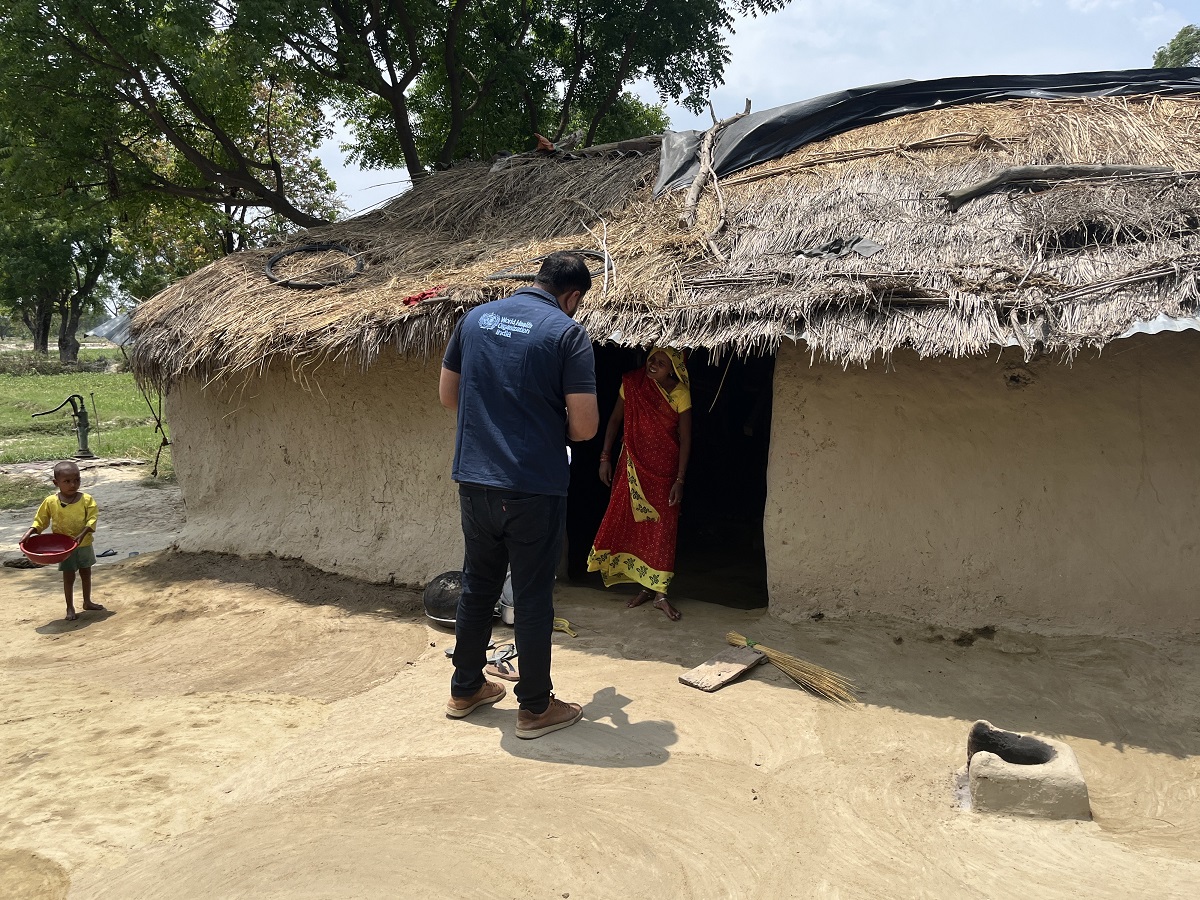
December 2023 | Amethi, Uttar Pradesh
A WHO surveillance medical officer conducts house-to-house visits to survey the immunization status of all children in Amethi district’s high-risk Shekhpura village, which has a high number of ‘zero doser’ children and has recorded measles outbreaks. WHO-National Public Health Support Network is supporting the Uttar Pradesh government in identifying and vaccinating unvaccinated and under-vaccinated children in the district. (Photo: Hiralal / © WHO India)
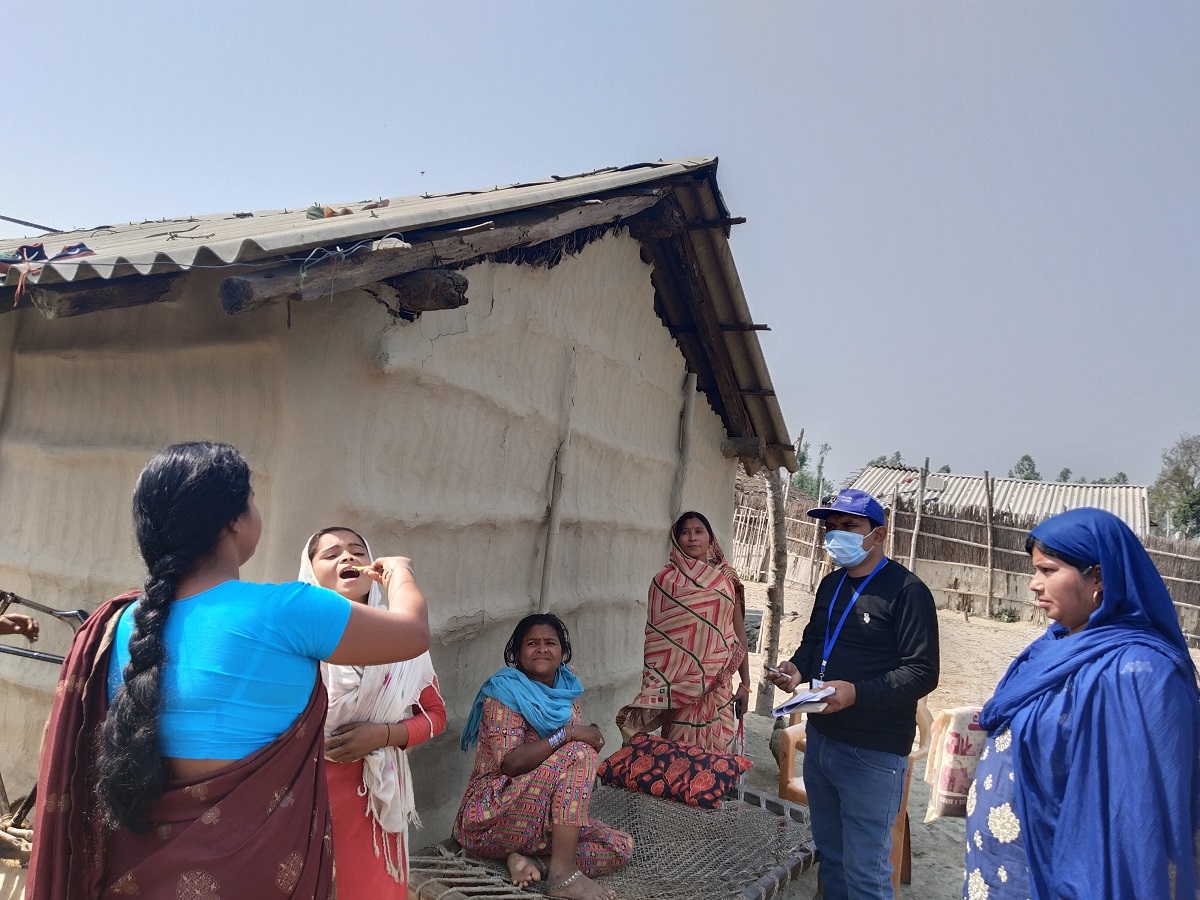
December 2023 | Bahraich, Uttar Pradesh
A WHO field team conducting active case search (ACS) during a fever with rash outbreak in Bardiya village, Mihinpurwa block in Bahraich district. Quality ACS helps in identifying clustering of cases for timely intervention to stop outbreaks. The WHO-National Public Health Support Network assists the government in capacity building, monitoring activities, ensuring timely interventions, planning vaccinations, and maintaining optimal disease surveillance. (Photo: Poonam / © WHO India)
_pc-pushpraj-dwivedi-fm.jpg?sfvrsn=6f99c8ca_2)
December 2023 | Chitrakoot, Uttar Pradesh
A WHO-National Public Health Support Network (NPSN) officer verifying a suspected diphtheria case in Shivrampur block in Chitrakoot district to identify new cases and validate the immunization status of children. WHO-NPSN teams support the government in vaccine-preventable disease surveillance to track suspected diphtheria cases, timely initiation of antibiotic prophylaxis for close contacts, and vaccination of unimmunized children in the community. (Photo: Than Singh / © WHO India)

December 2023 | Jhansi, Uttar Pradesh
A WHO surveillance medical officer visits a high-risk stone crusher site in Baragaon, Jhansi district, to monitor the polio vaccination status of children living with their parents around the site. The WHO-National Public Health Support Network assists the government in capacity building, monitoring activities, ensuring timely interventions, planning vaccinations, and maintaining optimal disease surveillance. (Photo: Raman Lal /© WHO India)

December 2023 | Purbi Champaran, Bihar
A WHO-National Public Health Support Network team monitoring routine immunization through house-to-house visits in the high-priority villages around Bankatwa Sub-Centre area bordering Nepal. (Photo: Haseen Khan / © WHO India)
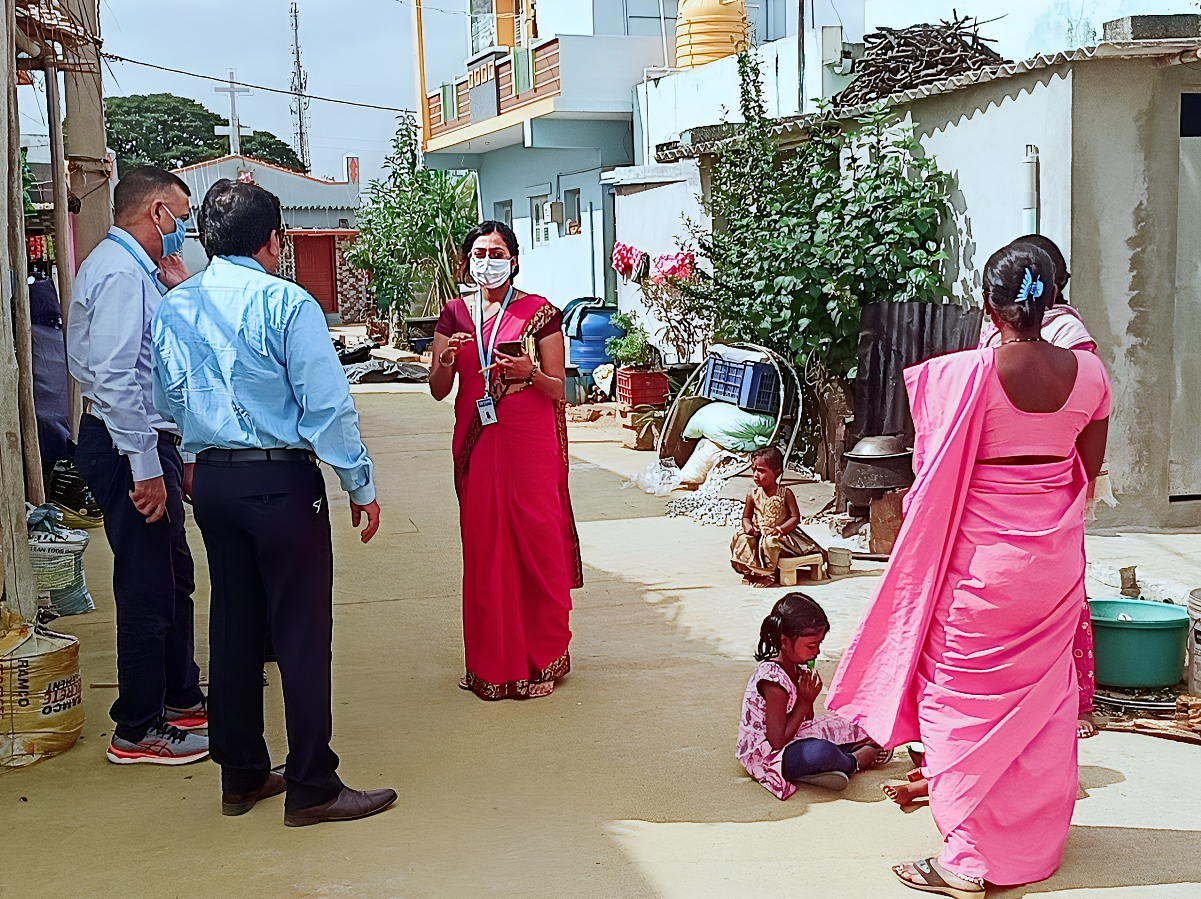
December 2023 | Chikkaballapur, Karnataka
A WHO-National Public Health Support Network (NPSN) team validating a headcount survey conducted by ASHAs in an urban slum in the high-risk district of Chikkaballapur to identify children who missed measles and rubella vaccination doses. WHO-NPSN teams support the government in advocating, capacity building, planning, and monitoring of immunization status of children for full immunization of children. (Photo: Gayithri D G / © WHO India)
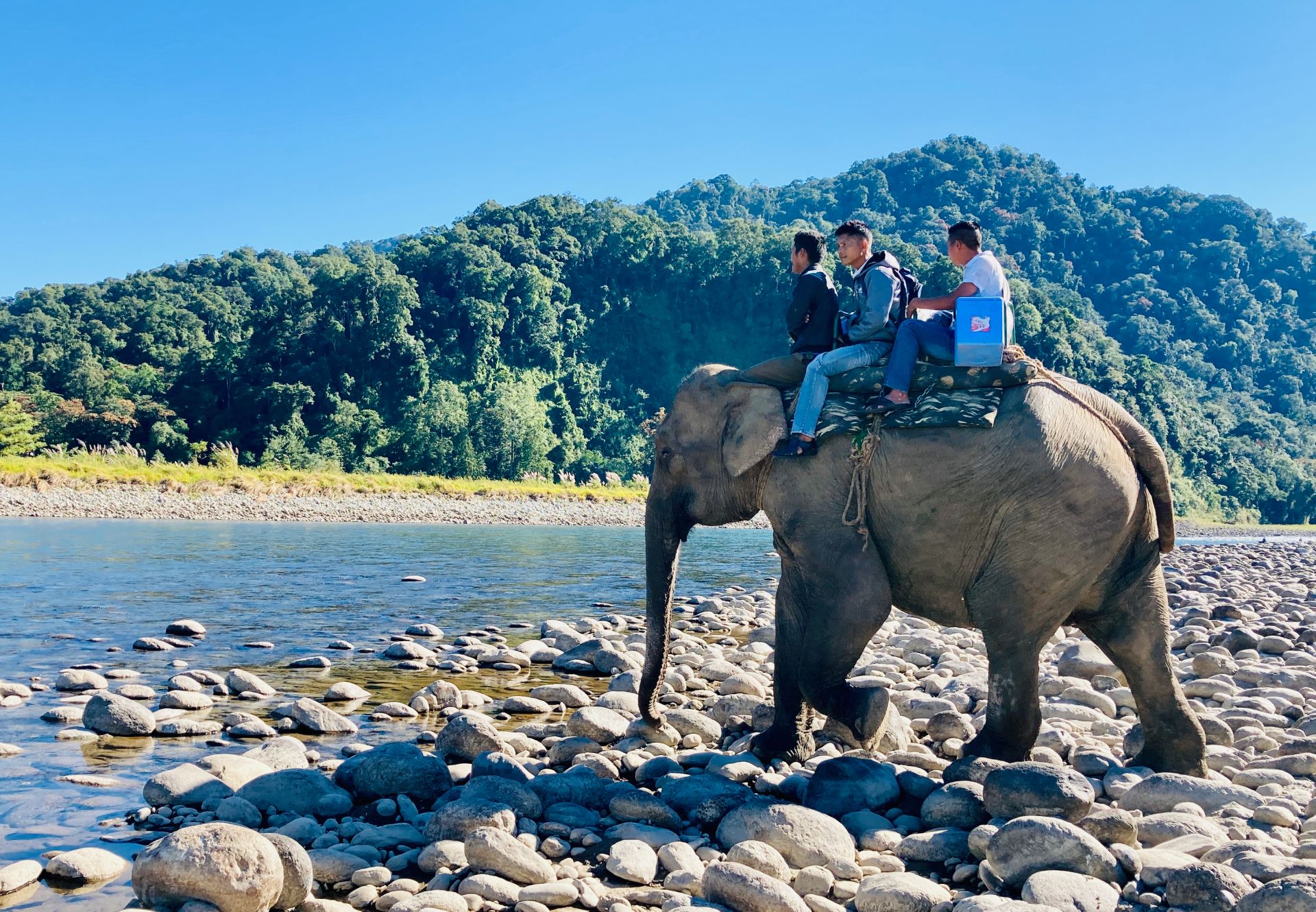
December 2023 | Changlang, Arunachal Pradesh
Lakhi, mother of two healthy elephants, carries lifesaving vaccines across the Noa-Dihing river to protect human children in Deban village in the Changlang district of Arunachal Pradesh. (Photo: Sanchita Sharma / © WHO India)
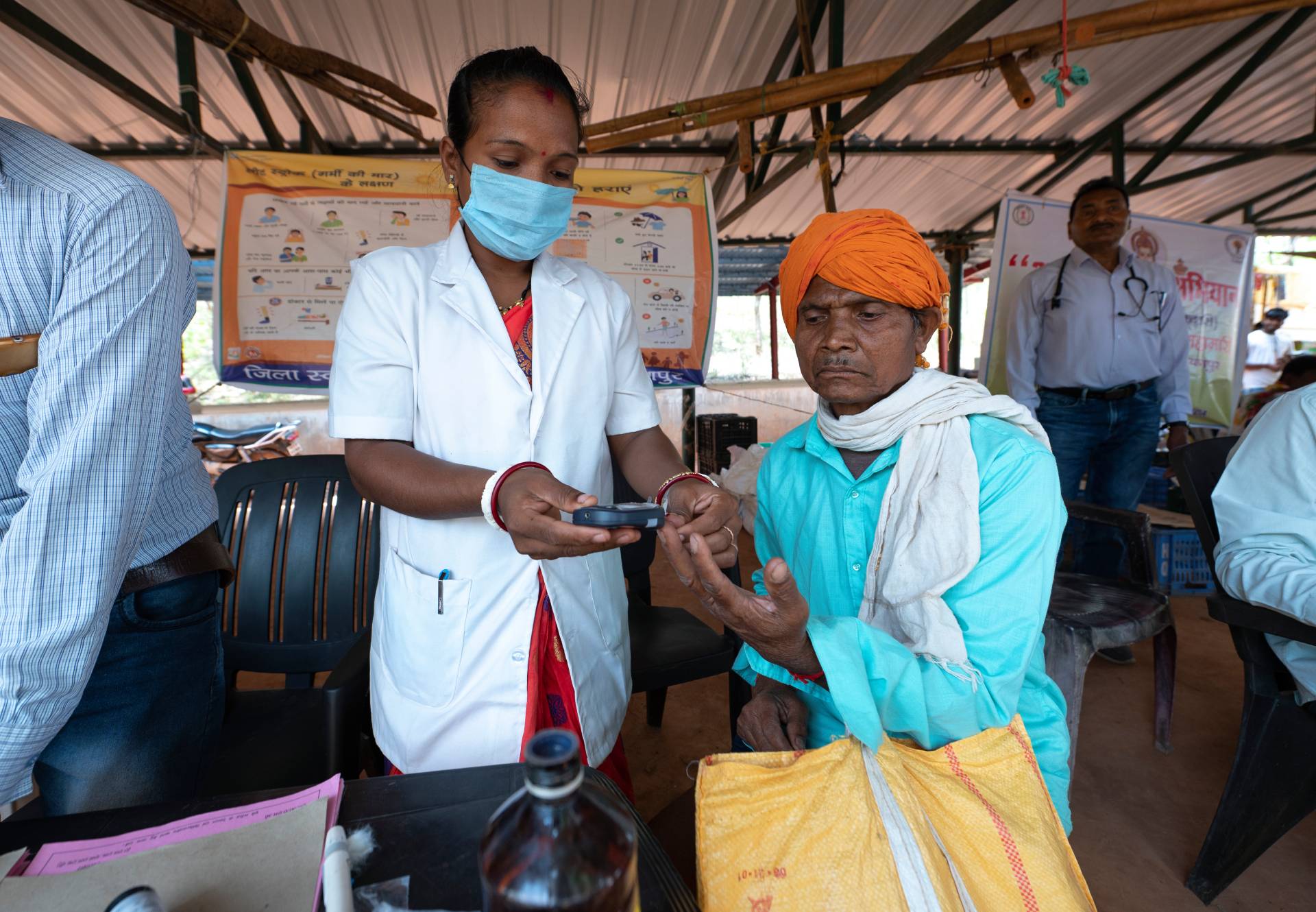
November 2023 | Narayanpur, Chhattisgarh
A visitor to a haat bazaar (rural market) in the Narayanpur district of Chhattisgarh gets screened for diabetes under India’s comprehensive primary health care services. The country aims to put 75 million people on standard care for diabetes and hypertension by 2025. Diabetes and hypertension are a leading risk factors for #noncommunicable diseases, such as heart disease, kidney failure, and stroke, among others. #WorldDiabetesDay. (Photo: Rajiv Solanki / © WHO India)
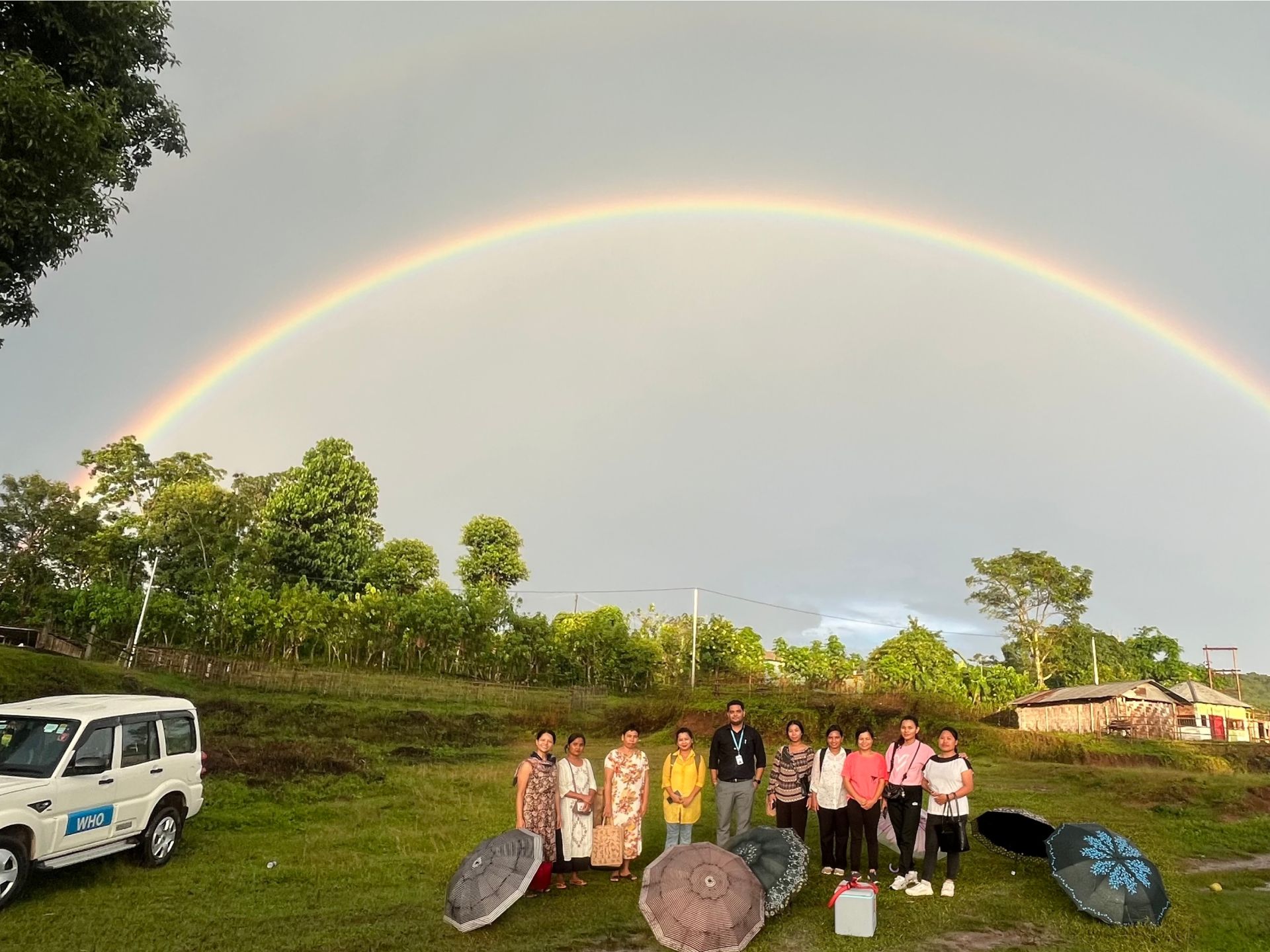
September 2023 | Ri Bhoi, Meghalaya
WHO National Public Health Support Network teams supported special sessions of Intensified Mission Indradhanush 5.0 (IMI 5.0) following a lab-confirmed measles outbreak in Laru village in the Bhoirymbong block of Ri Bhoi district in Meghalaya. WHO India is supporting the state in planning immunization activities in hard-to-reach areas around the Assam-Meghalaya border. (Photo: Pradeep Modak / © WHO India)
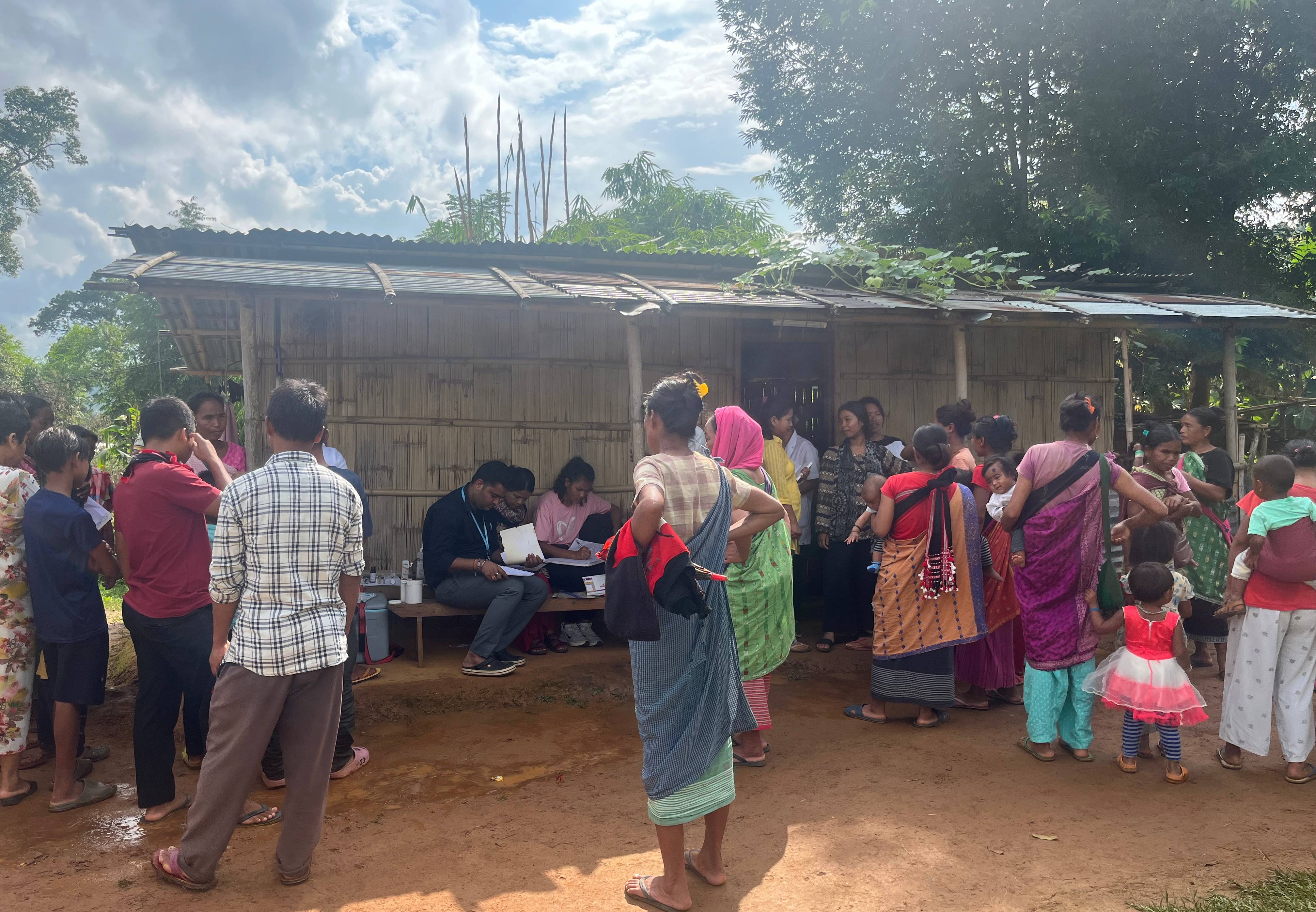
September 2023 | Ri Bhoi, Meghalaya
Following a lab-confirmed measles outbreak, women bring young children to get vaccinated at a special IMI 5.0 session conducted in the hard-to-reach Laru village in the Bhoirymbong block of Ri Bhoi district of Meghalaya. Laru is inaccessible on rainy days and can only be reached by walking for over an hour on hilly terrain. WHO National Public Health Support Network is assisting the district administration in ensuring all eligible children receive age-appropriate vaccines. (Photo: Pradeep Modak / © WHO India)
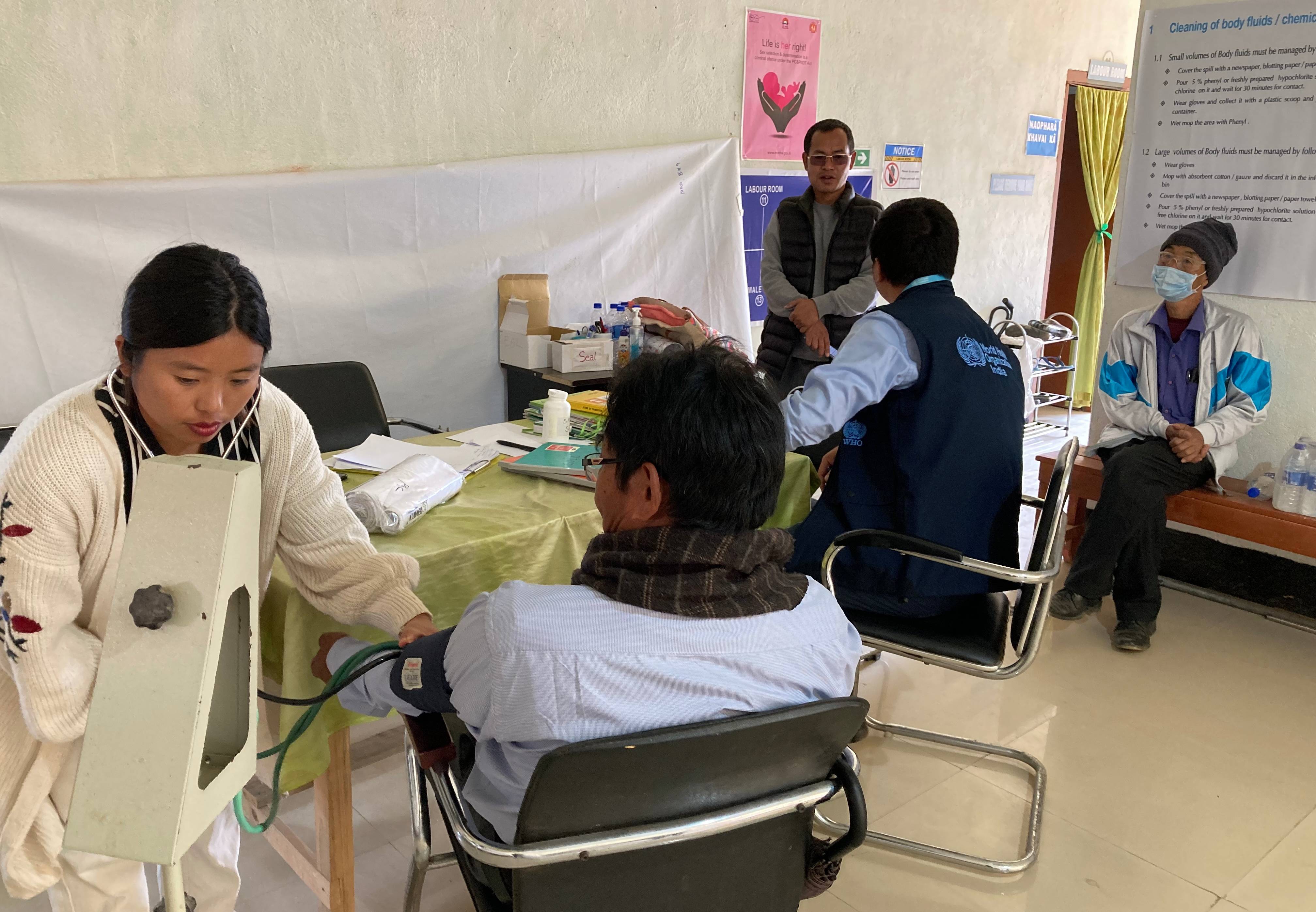
September 2023 | Kamjong, Manipur
An auxiliary nurse midwife monitors the blood pressure of a patient at Primary Health Centre Phungyar in the Kamjong district of Manipur. India aims to put 75 million people on standard care for hypertension and diabetes under India Hypertension Control Initiative by 2025. Uncontrolled blood pressure is one of the main risk factors for cardiovascular diseases, which are responsible for one-third of all deaths in India. (Photo: Sanchita Sharma / © WHO India)
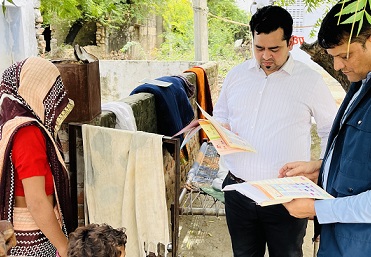
August 2023 | Tonk, Rajasthan
WHO National Public Health Support Network (NPSN) officers supported house-to-house monitoring of the vaccination status of children during Intensified Mission Indradhanush (IMI 5.0) in Bairwa Basti, Jhilai, Block Niwai in Tonk district of Rajasthan. (Photo: Khushal Goyar / © WHO India)
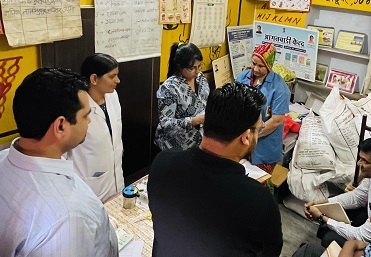
August 2023 | Tonk, Rajasthan
WHO National Public Health Support Network (NPSN) officers, government officials and partners conducting session site monitoring at Anganwadi Centre Balai Basti, Tonk Phatak, during Intensified Mission Indradhanush (IMI 5.0) in Rajasthan. (Photo: Khushal Goyar / © WHO India)
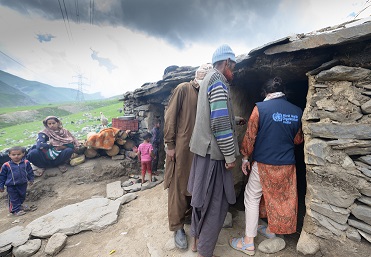
August 2023 | Rajouri, Jammu and Kashmir
A WHO health systems officer assisting the health department of Union Territory (UT) of Jammu and Kashmir in providing quality health services to the transhumance tribal communities in Peer Ki Gali, Rajouri district. WHO India is supporting the UT in health systems strengthening to reach the most vulnerable communities in hard-to-reach areas. (Photo: Rajiv Solanki / © WHO India)
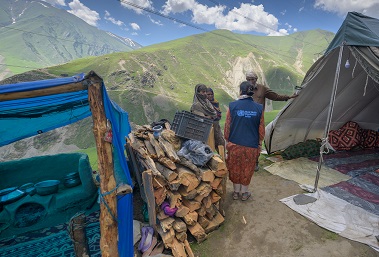
August 2023 | Rajouri, Jammu and Kashmir
A WHO health systems officer counsels a nomadic tribal family on the importance of deworming and routine immunization for child health at their temporary settlement in Rajouri district in the Jammu division of the Union Territory of Jammu and Kashmir. WHO India is supporting the UT in health systems strengthening to reach the most vulnerable communities in hard-to-reach areas. (Photo: Rajiv Solanki / © WHO India)
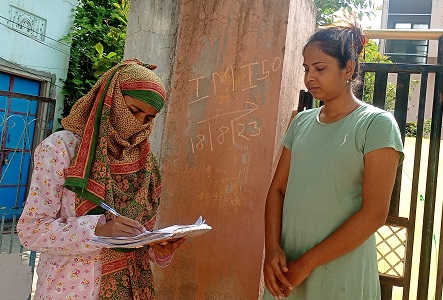
AUGUST 2023 | Jaipur, Rajasthan
ASHA (community health volunteer) Ms Mamta Devi conducting house-to-house survey to record the vaccination status of children during Intensified Mission Indradhanush (IMI 5.0) in Urban Primary Health Centre Ward 46, Jaipur Urban. WHO National Public Health Support Network (NPSN) provided capacity-building support to health department’s frontline workforce to identify and vaccinate all unvaccinated and under-vaccinated children under the age of five years. (Photo: Seema Gurjar / © WHO India)
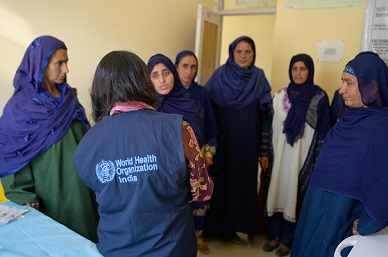
August 2023 | Bandipora, Jammu and Kashmir
A WHO health systems officer and ASHAs discuss best practices and challenges in delivering health services to nomadic communities in hard-to-reach areas being served by PHC-HWC Bagtore in Gurez, Bandipora District in the Union Territory of Jammu and Kashmir. (Photo: Rajiv Solanki / © WHO India)
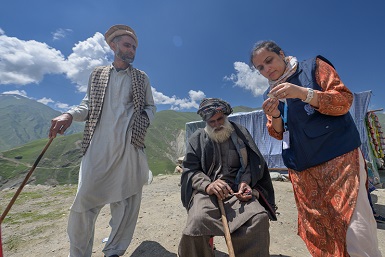
August 2023 | Rajouri, Jammu and Kashmir
A WHO health systems officer observes health services, including health check-ups, being provided by the health department’s mobile medical aid team at a temporary settlement of the Bakarwal nomadic tribe in Peer Ki Gali, Rajouri district, in the Jammu division of the Union Territory (UT) of Jammu and Kashmir. (Photo: Rajiv Solanki / © WHO India)
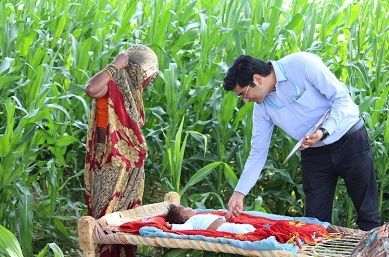
August 2023 | Etawah, Uttar Pradesh
A WHO surveillance medical officer monitoring the immunization status of a newborn in Jashwantnagar town in Etawah district. (Photo: B. S. Chandel / © WHO India)
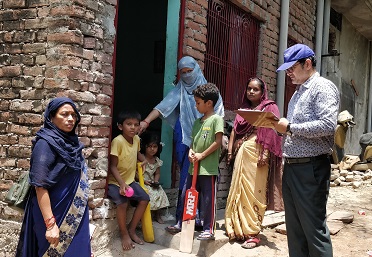
August 2023 | Varanasi, Uttar Pradesh
A WHO-National Public Heath Support Network (NPSN) officer conducting house-to-house surveillance in the Ordali Bazar neighbourhood of Varanasi for the Sub National Immunization Day. WHO-NPSN teams support the government in capacity building, planning, and monitoring of polio vaccination. (Photo: Kashi Nath / © WHO India)
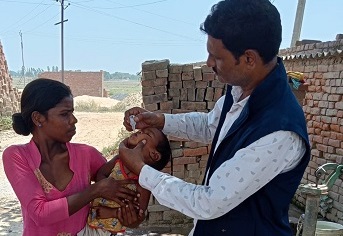
August 2023 | Azamgarh, Uttar Pradesh
A WHO-National Public Heath Support Network (NPSN) surveillance medical officer giving polio drops to a child at Jamudi Bhatta brick-kiln in Satiyaon for the Sub National Immunization Day. WHO-National Public Heath Support Network (NPSN) teams support the government in capacity building, planning, and monitoring of polio vaccination. (Photo: Vijay / © WHO India)
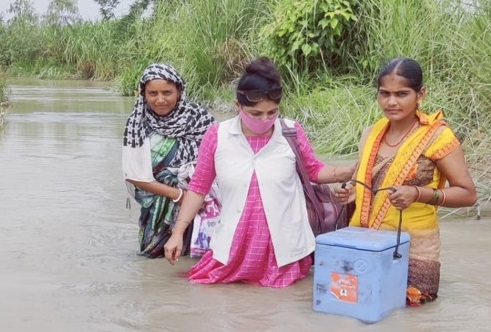
August 2023 | Pilibhit, Uttar Pradesh
Auxiliary nurse midwife Jeetendra Kaur (centre) and ASHAs Kiran Devi and Savita Rani carrying vaccines for the first round of Intensified Mission Indradhanush 5.0 (IMI 5.0) in the flooded Rahul Nagar Majdoori Basti village in Puranpur. On August 7, India launched the first of three rounds of IMI 5.0 to identify and vaccinate all unvaccinated and under-vaccinated children under the age of five years. (Photo: © WHO India)
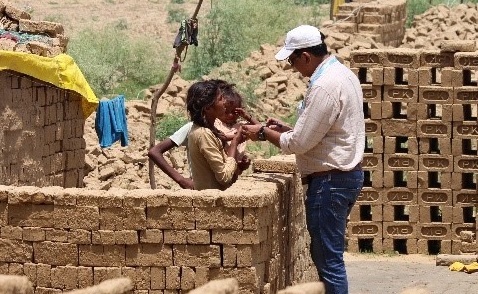
August 2023 | Etawah, Uttar Pradesh
A WHO surveillance medical officer monitoring the immunization status of children at a brick kiln in Jashwantnagar town. Workers at brick kilns migrate for work, which makes their children vulnerable to missing scheduled vaccination doses. (Photo: Manoj / © WHO India)
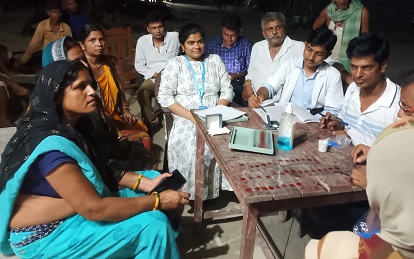
July 2023 | Samastipur, Bihar
An ASHA (in blue sari) describes how she mobilizes people for blood sample collection between 20:30. and midnight to test for microfilariae, which transmit lymphatic filariasis (LF). At first, people refuse to cooperate for blood collection at night, but readily agree when she explains that blood surveys must be done at night to identify areas with high transmission (greater than 1%) for mass drug administration for LF elimination. Annual microfilaria survey was conducted in all blocks of Samastipur district, Bihar, in June 2023. (© WHO India)
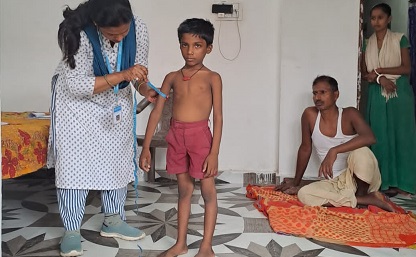
July 2023 | Begusarai, Bihar
A WHO surveillance medical officer examines a child who had developed Acute Flaccid Paralysis (AFP) during a follow-up visit in Teghra, Begusarai district. Since AFP is also a symptom of polio, all cases are screened 60 days after the onset of paralysis to rule out polio as part of continuing surveillance to ensure India remains polio free. (© WHO India)
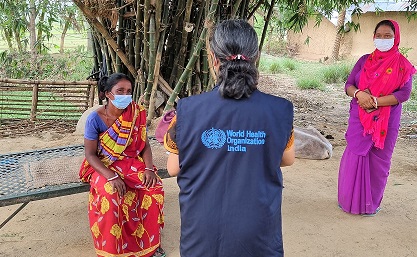
June 2023 | Murshidabad, West Bengal
A woman from Murshidabad district of West Bengal is simultaneously getting treated for leprosy, leishmaniasis, and tuberculosis (TB). WHO field teams routinely accompany the district medical team to monitor her treatment against all three diseases. The team also ensures her family is protected with TB Preventive Treatment and she receives regular nutritional support under National TB Elimination Programme. (© WHO India)
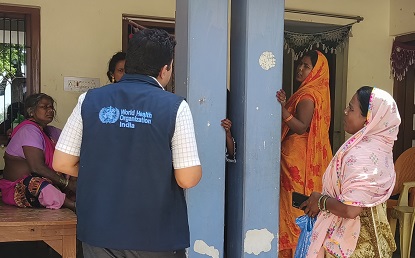
June 2023 | Mau, Uttar Pradesh
WHO teams conducted house-to-house visits in Kopaganj block in Mau district to ensure that no child missed polio vaccination during Sub-National Immunization Day on 28 May. WHO is providing technical and field support to national and state governments to maintain India's polio-free status. (Photo: Rambachan Bharati /© WHO India)

May 2023 | Mau, Uttar Pradesh
A WHO-National Public Heath Support Network (NPSN) officer reviewing the daily activity plan with frontline workers in Doharighat block, Mau district. WHO-NPSN supports the government in capacity building, planning, and monitoring of polio vaccination. (Photo: Rambachan Bharati /© WHO India)
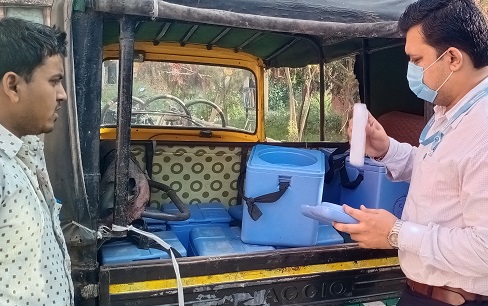
May 2023 | Mau, Uttar Pradesh
A WHO surveillance medical officer inspects ice packs and vaccine carriers at a cold chain centre in Mau to ensure the safety and potency of vaccines during transit. (Photo: Rambachan Bharati /© WHO India)
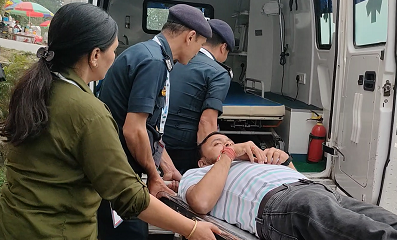
May 2023 | Gangtok, Sikkim
A person being brought to STNM Hospital Gangtok in Sikkim during a mock drill in resilience planning, emergency response and disaster management under the Government of Sikkim’s Resilient Health Infrastructure Programme. The initiative is being supported by WHO India and Coalition for Disaster Resilient Infrastructure. (Photo: Girish Chandra Dash / © WHO India)

April 2023 | Delhi
WHO Representative to India Dr Roderico H. Ofrin with a child who is getting immunized at Urban Primary Health Centre Daryaganj in Delhi. WHO India provides technical and field support to the Government of India to immunize and protect every child. (Photo: Rajiv Solanki / © WHO India)
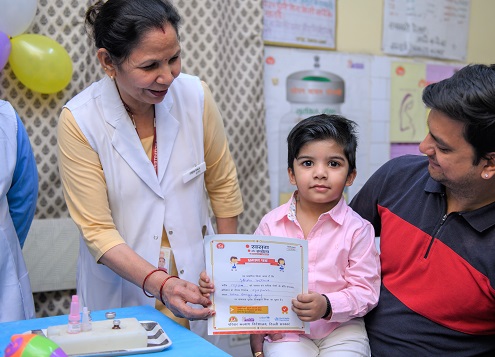
April 2023 | Delhi
Full immunization protects children against several vaccine-preventable diseases. A child proudly holds up his vaccination card after getting vaccinated against measles-rubella at an Urban Primary Health Centre in Delhi. (Photo: Rajiv Solanki / © WHO India)

March 2023 | Pherzawl, Manipur
WHO supported an advocacy session to reduce vaccine hesitancy in Toulbung village in the hard-to-reach district of Pherzawl in Manipur. With support from the village chief, the WHO field team organized an advocacy session with the community to share information, respond to queries, and address misconceptions about vaccination. (Photo: © WHO India)
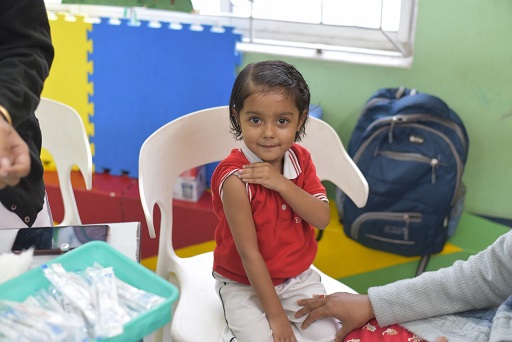
March 2023 | West Bengal
Over 22.3 million children between the ages of nine months and 15 years have been vaccinated as part of a measles and rubella (MR) catch-up campaign launched on 9 January 2023 in West Bengal.
WHO teams are working with the government in MR surveillance, strengthening immunization, outbreak response, strengthening laboratory network. (Photo: © WHO India)
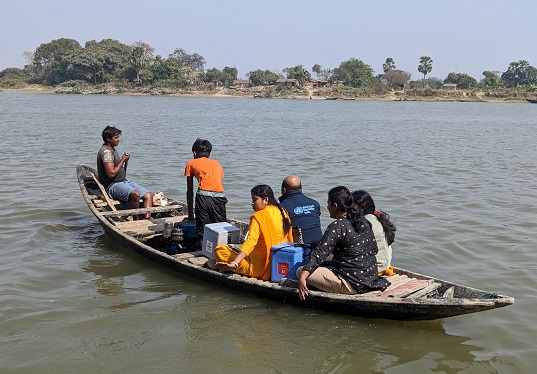
March 2023 |West Bengal
Reaching the unreached! A WHO team on its way to the Bansberia Char, a riverine island, in Hooghly for a vaccination session.
WHO is committed to working with Member States to ensure access to life-saving vaccines! (Photo: © WHO India)
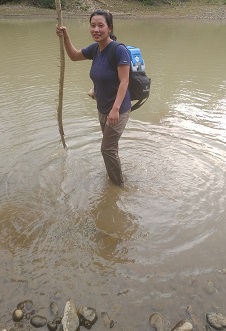
March 2023 | Tamenglong, Manipur
Nurse Ms Karnuale Pame carrying vaccines across River Jiri to Impa Ningdi village under Tousem subdivision in Tamenglong district, Manipur, for Routine Immunization. It takes 3.5 hours to reach Impa Nigdi from Aben Sub-Centre, where Ms Pame supports ANM Ms Thiamboi Gangmei cover the routine immunization sessions in 14 hard-to-reach villages. (Photo: © WHO India)
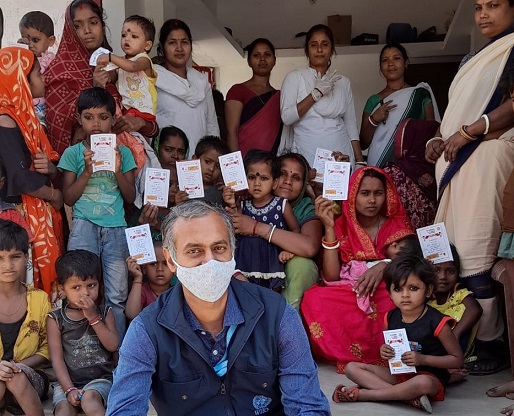
March 2023 | Jharkhand
As part of measles and rubella (MR) catch-up vaccination campaign, over 4.5 million children have been vaccinated across nine districts of Jharkhand this year.
Reaching at least 95% children in every district is essential for MR elimination.
WHO teams are working with the government in MR surveillance, strengthening immunization, outbreak response, strengthening laboratory network. (Photo: © WHO India)
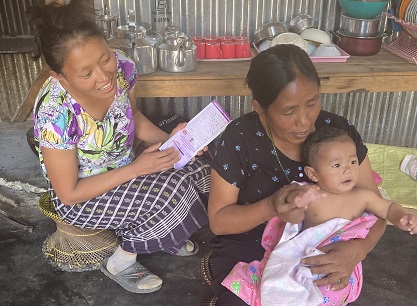
March 2023 | Kamjong, Manipur
ASHA Ms Alungwon (in black) plays with the baby as his mother gets the immunization card for review in Pabung village, Kamjong district, Manipur. WHO National Public Support Network provides technical and surveillance support to the Government of India to improve full immunization coverage in underserved and hard-to-reach areas. (Photo: Sanchita Sharma / © WHO India)
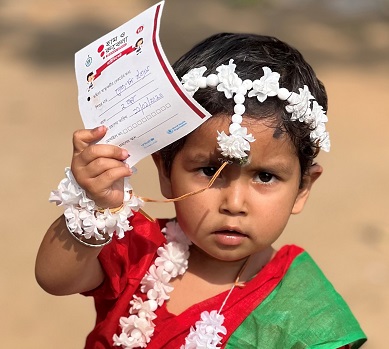
March 2023 | West Bengal
A girl holding up her vaccination card during the measles-rubella vaccination campaign in West Bengal. Measles is a highly contagious viral disease, rubella causes congenital birth defects. Vaccination prevents both diseases. WHO provides field support to the government for surveillance, strengthening full immunization, and ensuring universal access to life-saving vaccines.(Photo: © WHO India)
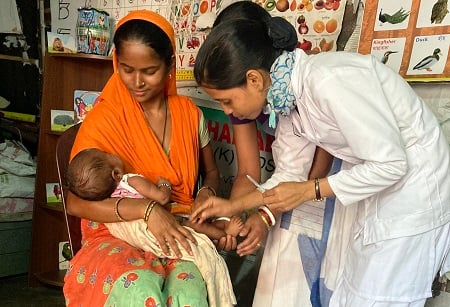
February 2023 | Guwahati, Assam
WHO supported Assam state government in conducting three rounds of Special Immunization Drive 2.0 from December 2022 to February 2023 to vaccinate all ‘drop out’ and ‘left out’ children and pregnant women under Universal Immunization Programme (UIP). Outreach immunization sites were set up in underserved areas to take UIP services to the community. (Photo: Sanchita Sharma / © WHO India)

February 2023 | Morigaon, Assam
ASHA worker Ms Nomita Paharia assists ANM Ms Anamika Das vaccinate three-months-old baby Ms Anu Mirda in the arms of her mother Ms Morimi Mirda in Morigaon district, Assam. The Government of India’s Universal Immunization Programme provides free vaccines to all children nationally against 11 diseases, and sub-nationally against Japanese encephalitis in endemic areas. (Photo: Sanchita Sharma / © WHO India)
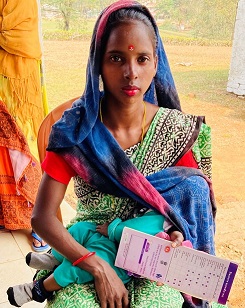
February 2023 | Morigaon, Assam
A mother waits her turn to get her son vaccinated at Gopal Krishna Tea Estate Hospital in Killing Valley, Morigaon district, Assam. WHO supported the state government conduct three rounds of Special Immunization Drive (SID) 2.0 from December 2022 to February 2023 to vaccinate all ‘drop out’ and ‘left out’ children and pregnant women under Universal Immunization Programme. (Photo: Sanchita Sharma / © WHO India)
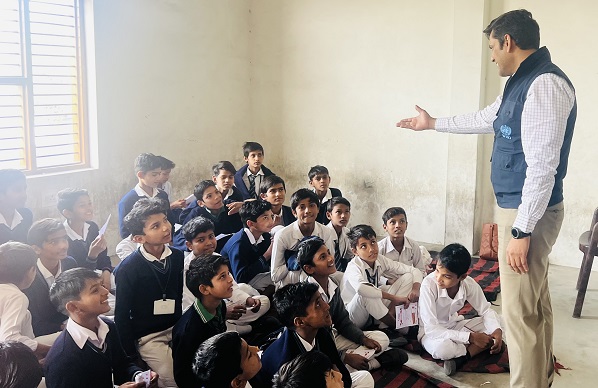
16 February 2023 | Delhi
Measles and rubella (MR) vaccination catch-up campaign was organized at Sunrise Public School in Nuh district, Haryana on 16 February 2023. Dr Puneet Mishra from WHO’s National Public Health Support Network speaks with students post their vaccination. (Photo: Nivedita Vasudeva / © WHO India)
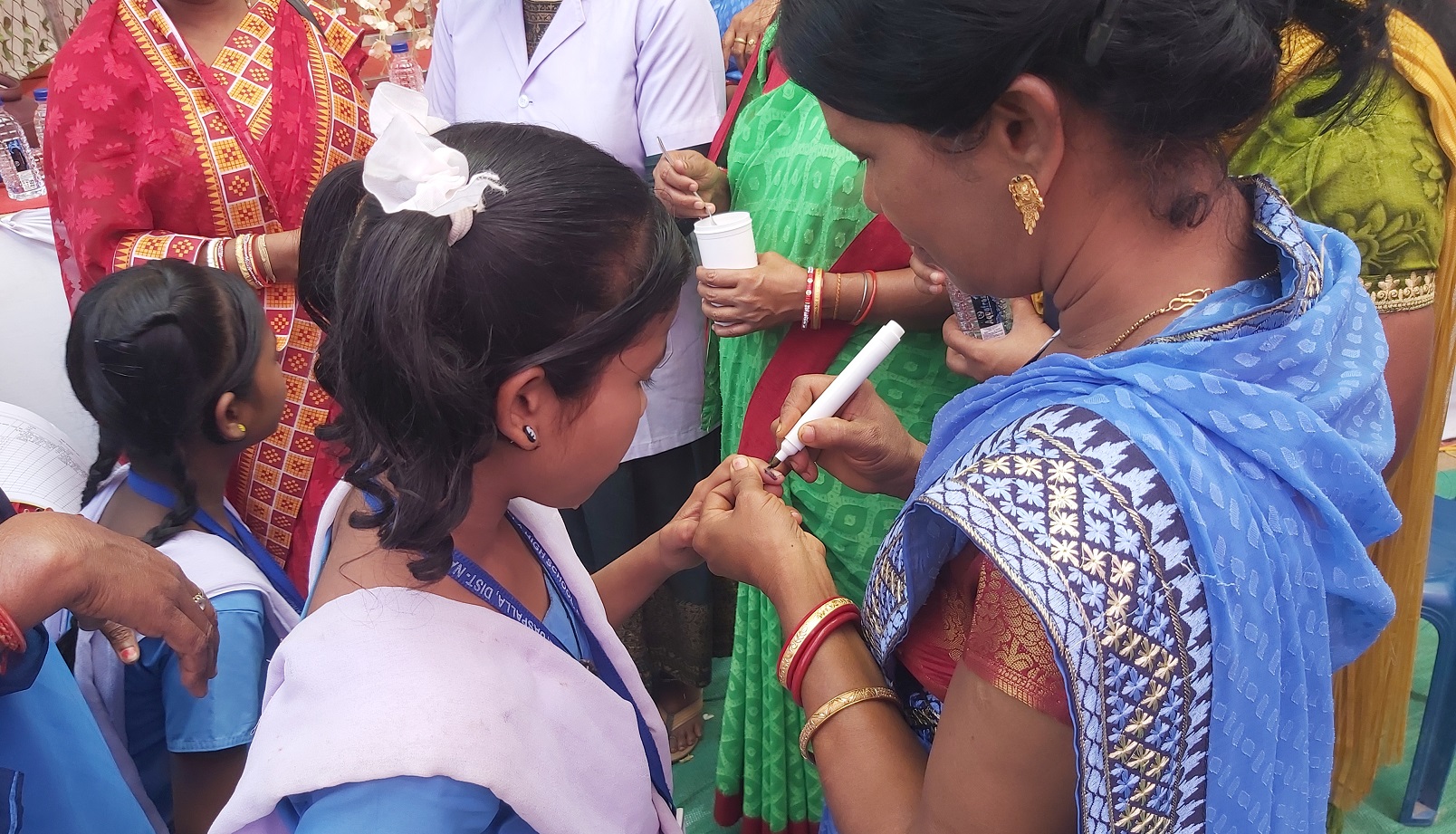
16 February 2023 | Odisha
ASHA Jhunubala Sahoo fingermarking a student after administering anti-filaria medication at Daspalla High School in Nayagarh district, Odisha. Under the ongoing MDA campaign, GoI is administering LF drugs to 640 million people at risk in 930 blocks in 90 affected districts in 10 states. WHO’s national and field teams are assisting the government in concurrent monitoring of MDA rounds. (©WHO India)

6 February 2023 | Delhi
Delhi has launched a six-week measles-rubella vaccination campaign on 6 February, to protect children between the ages of nine months and five years. Make sure your child gets MR vaccination. (Photo: Lakshmi Bamdoli / © WHO India)
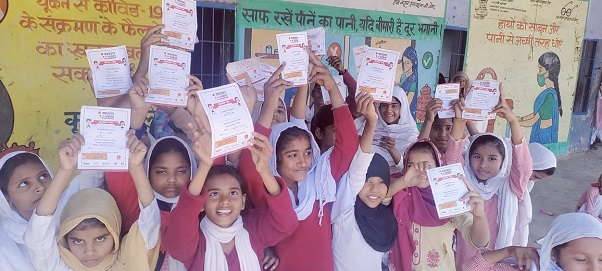
6 February 2023 |Nuh, Haryana
Haryana has launched a measles-rubella (MR) vaccination campaign on 6 February to vaccinate children (nine months to 15 years age group) in Nuh and Palwal districts with a goal to cover 470 000 children. WHO India’s National Public Health Support Network is providing planning and field support to the state and district administration to implement the vaccination drive. (Photo: Ravinder Pal Singh / © WHO India)
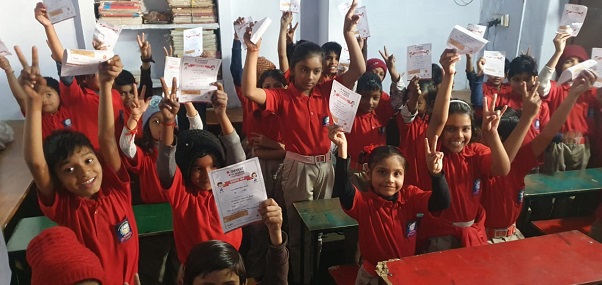
6 February 2023 | Nuh, Haryana
Vaccinated children hold up their measles-rubella (MR) vaccination certificates in Nuh district in Haryana. The state has launched an MR vaccination campaign on 6 February to vaccinate children in Nuh and Palwal districts, which reported 17 measles outbreaks in 2022. (Photo: Sanjeev Tanwar / © WHO India)
